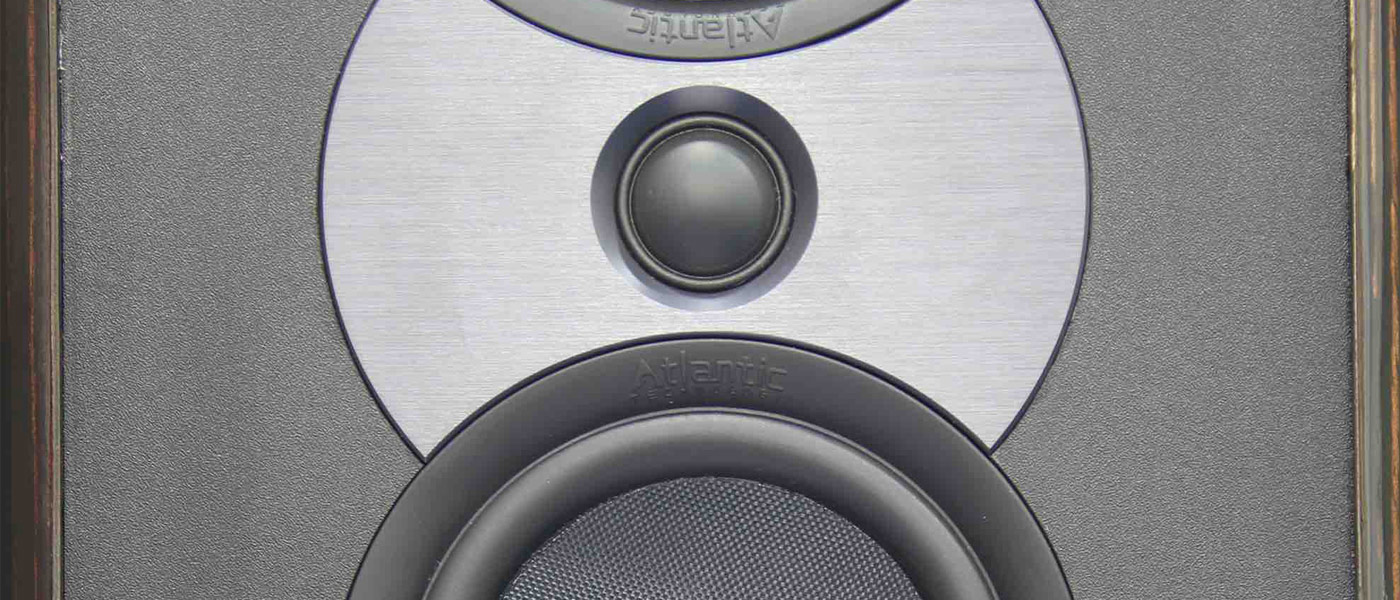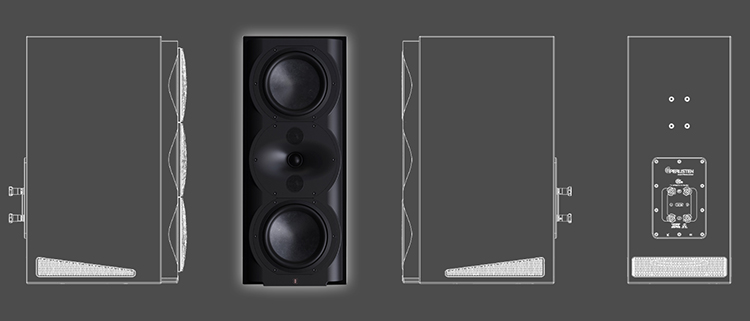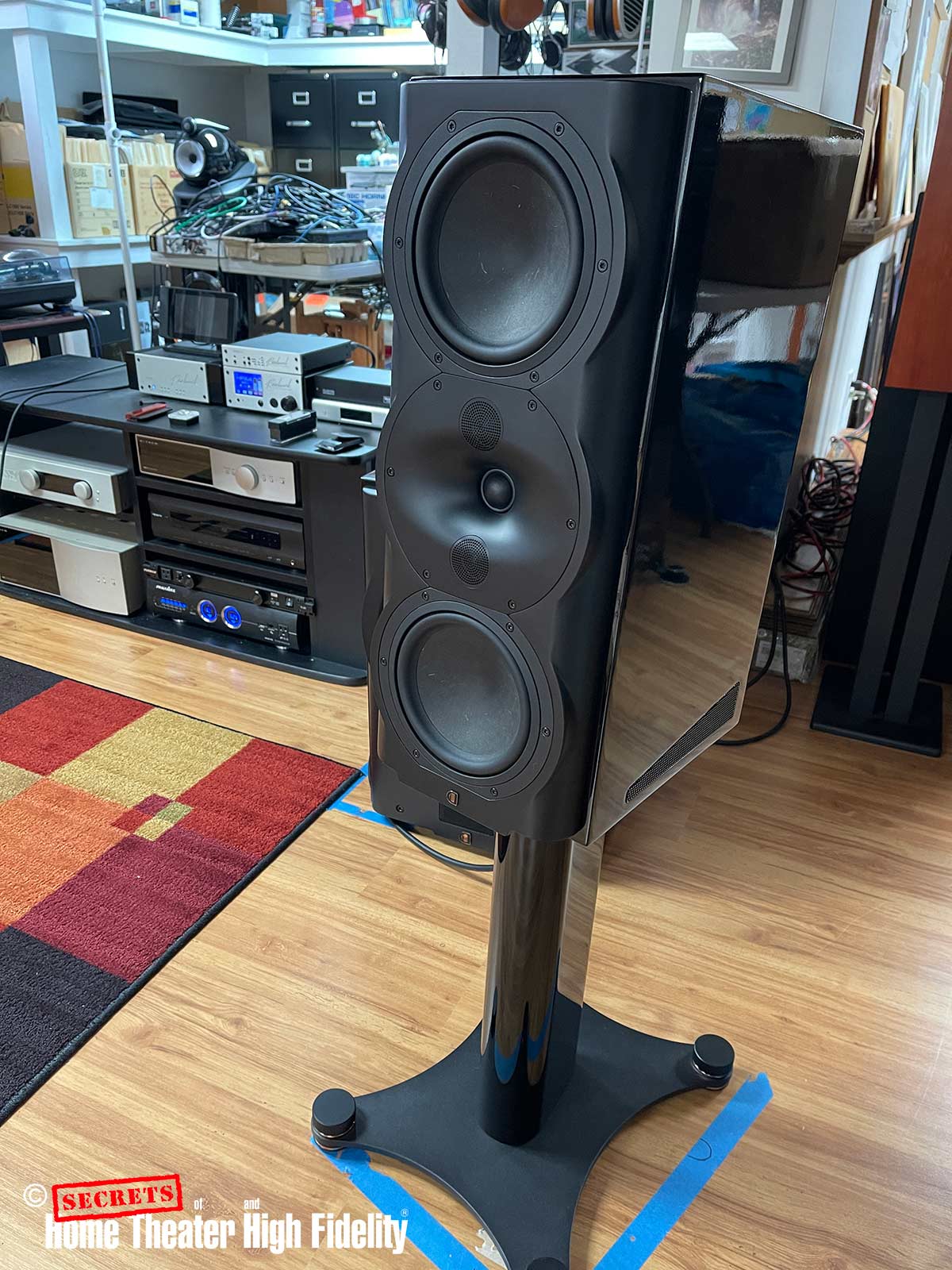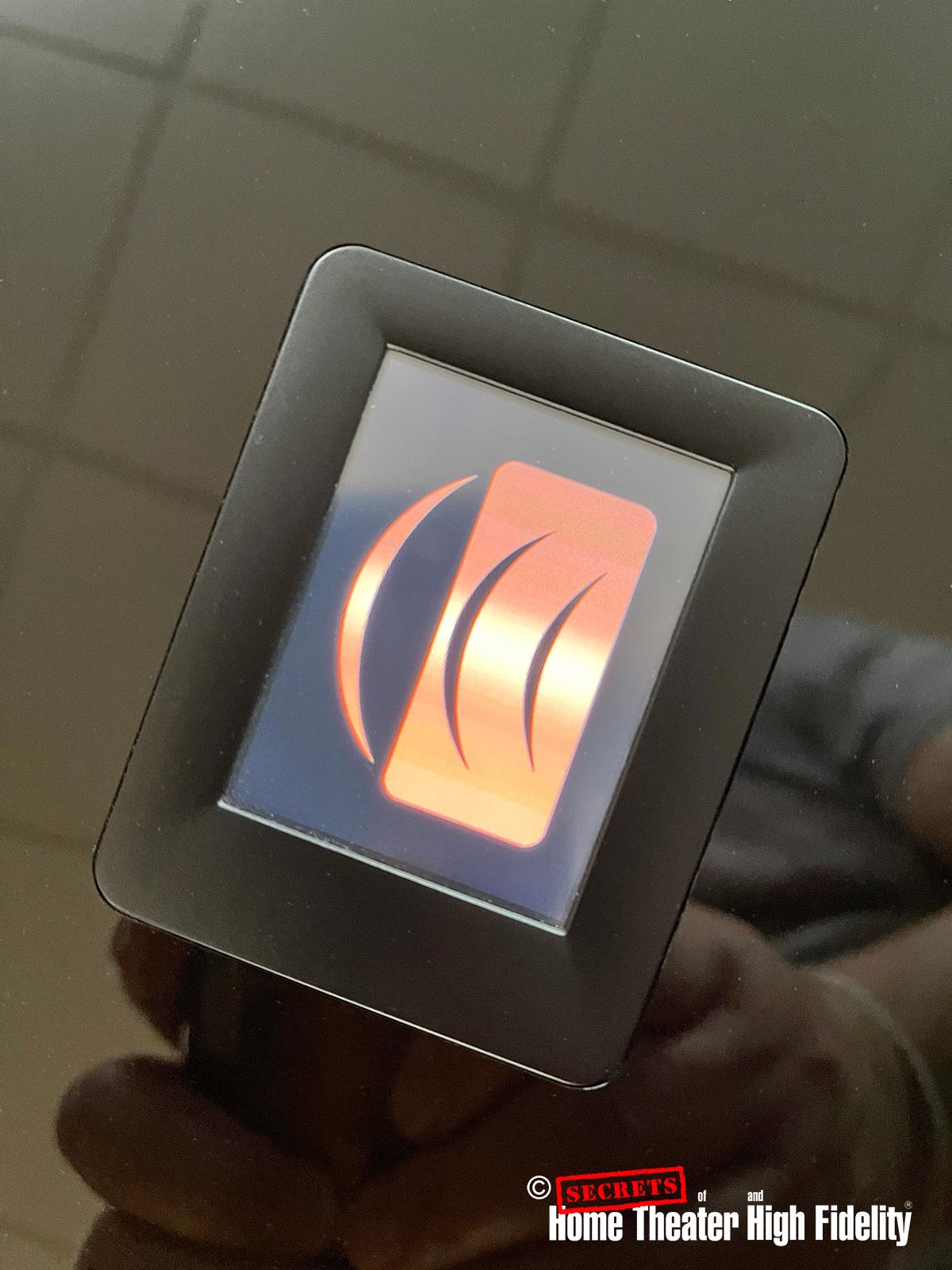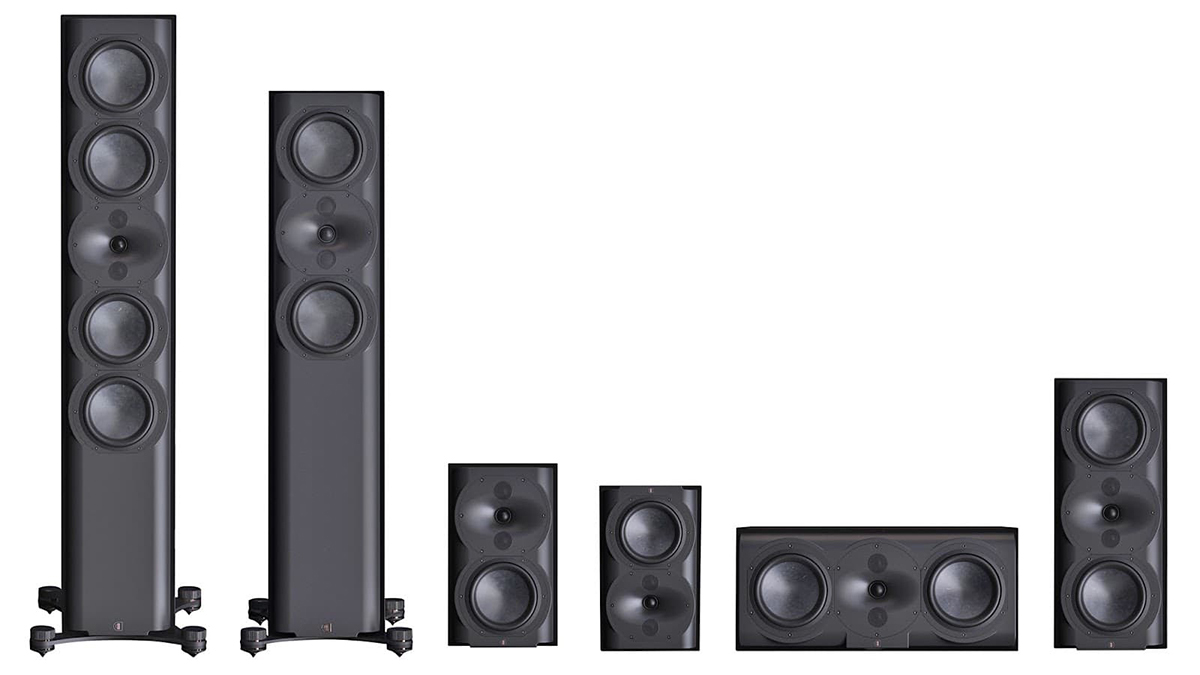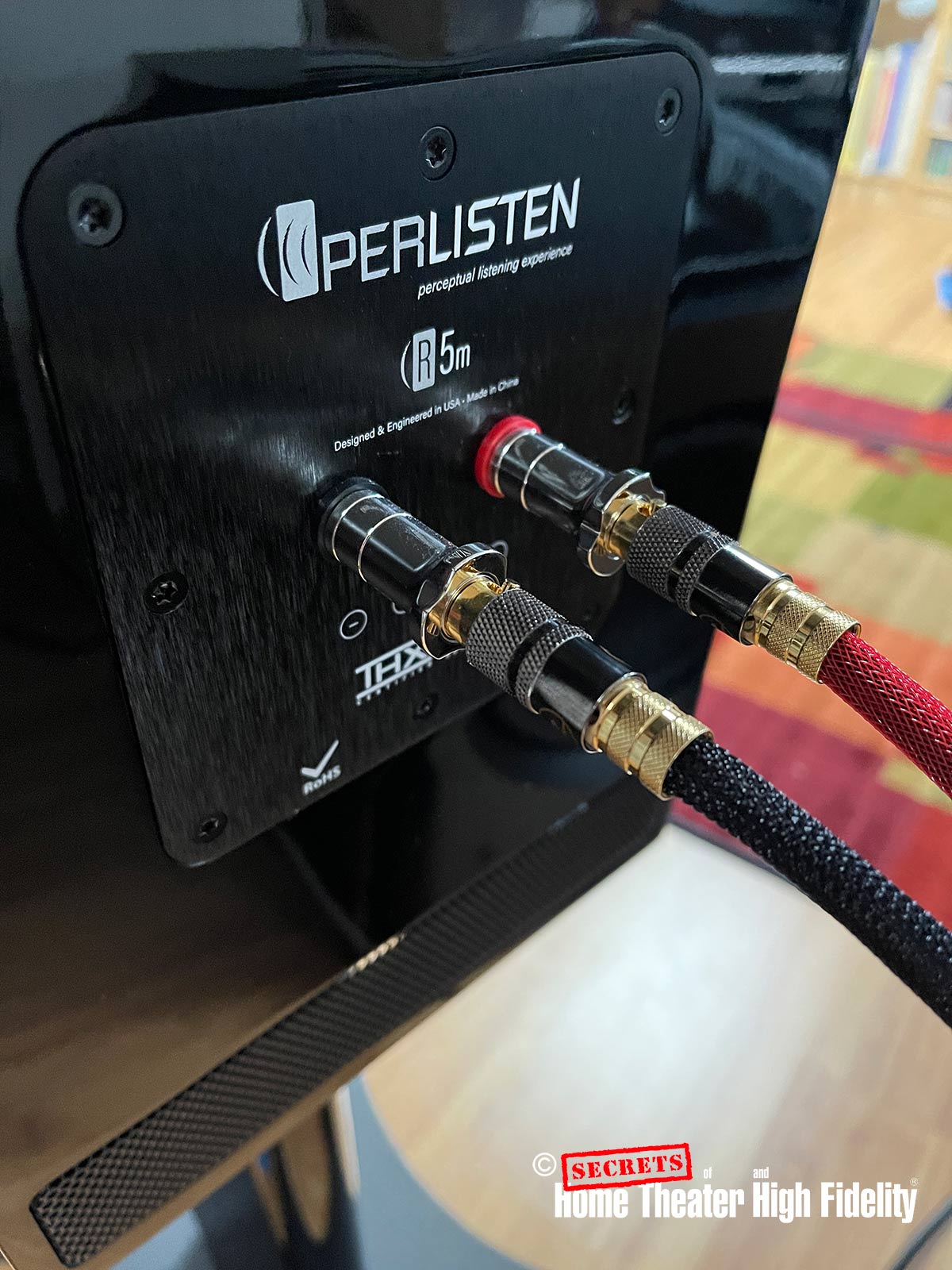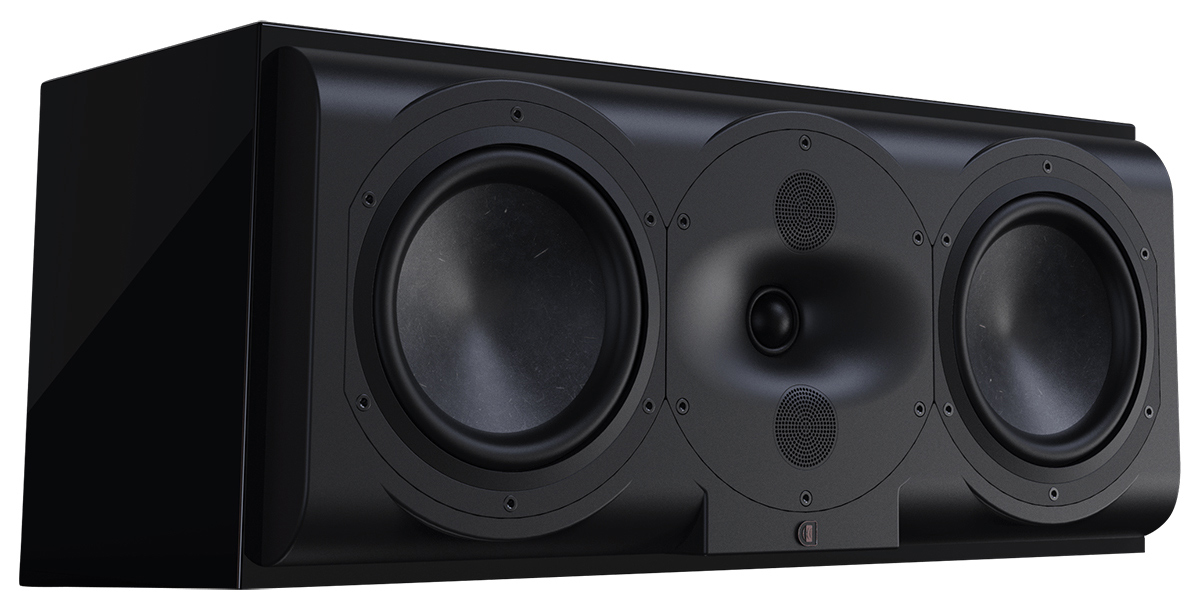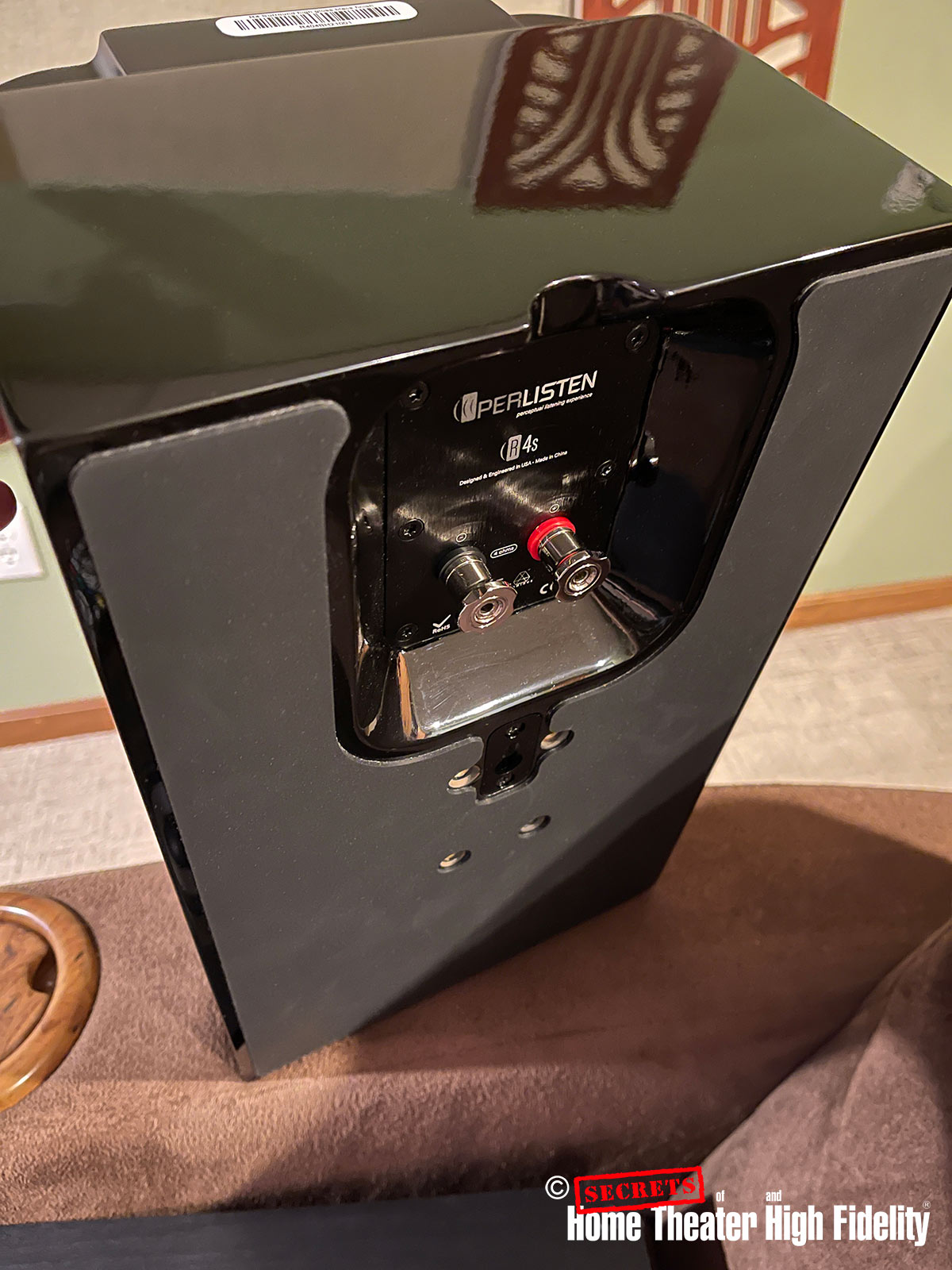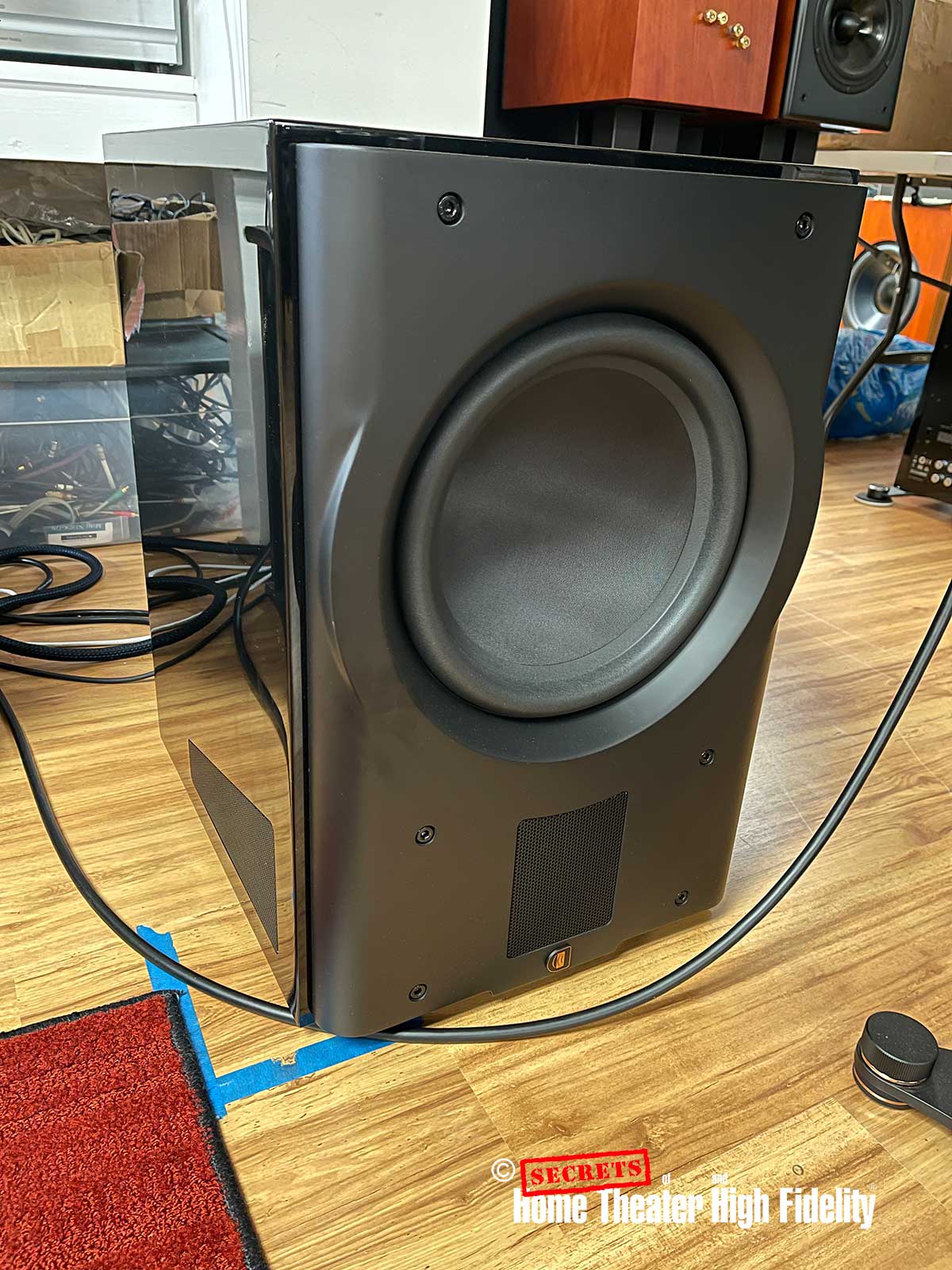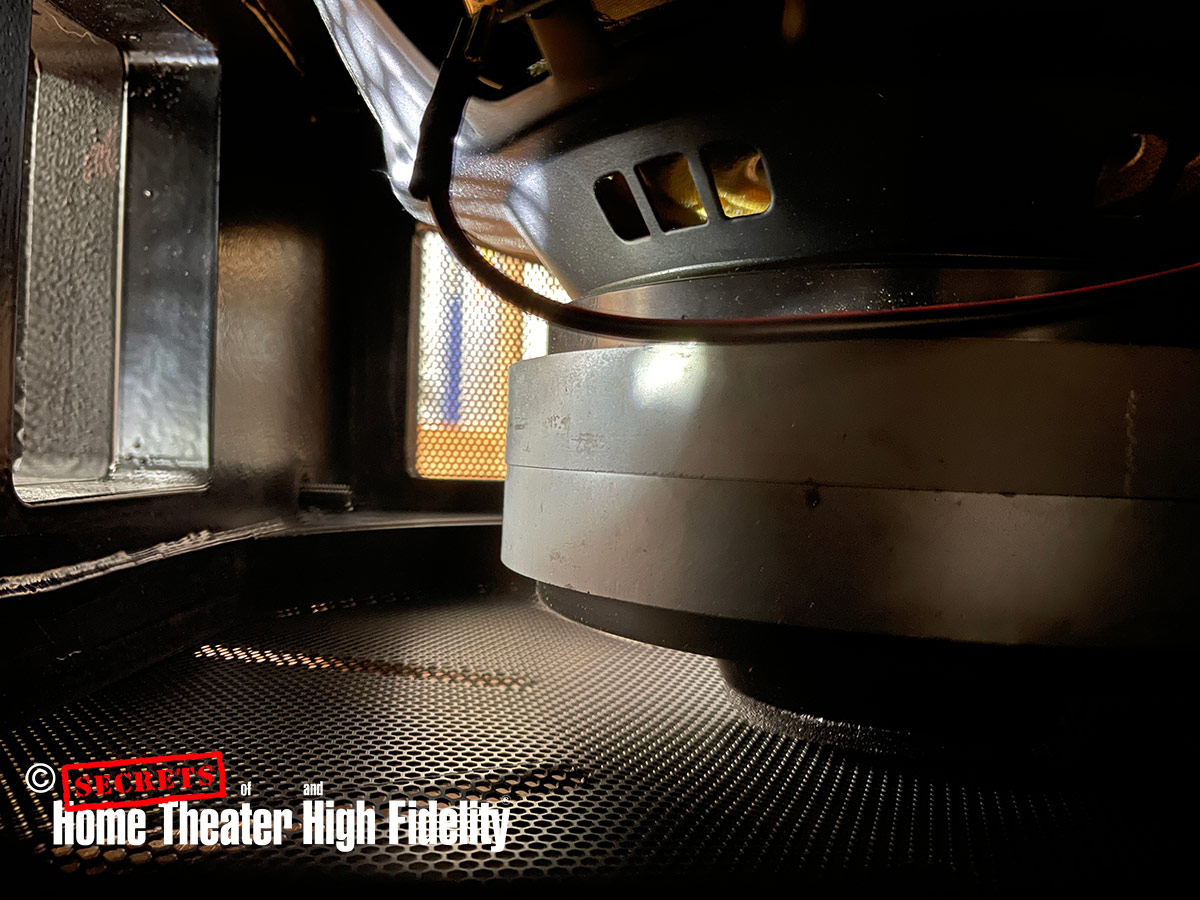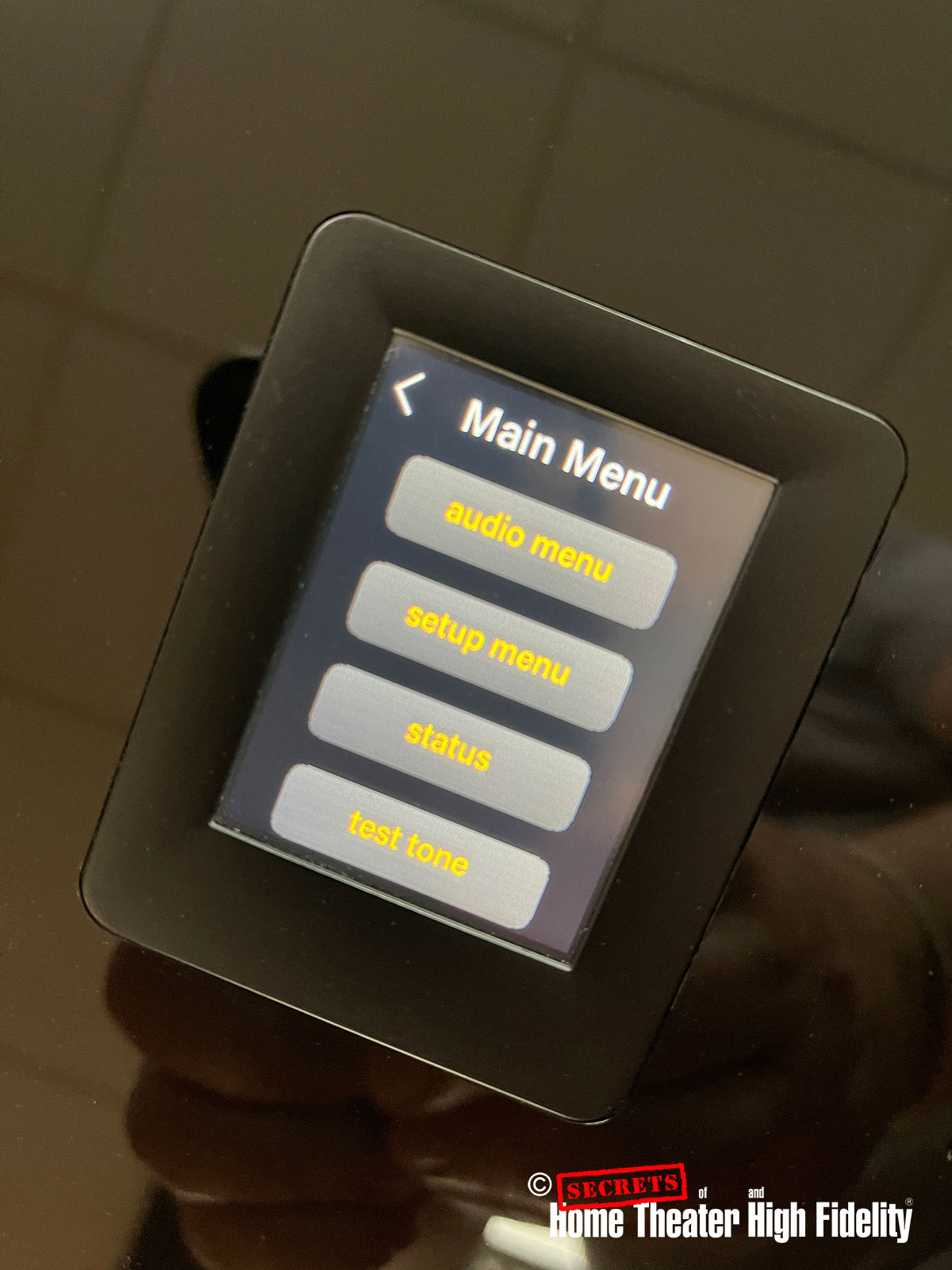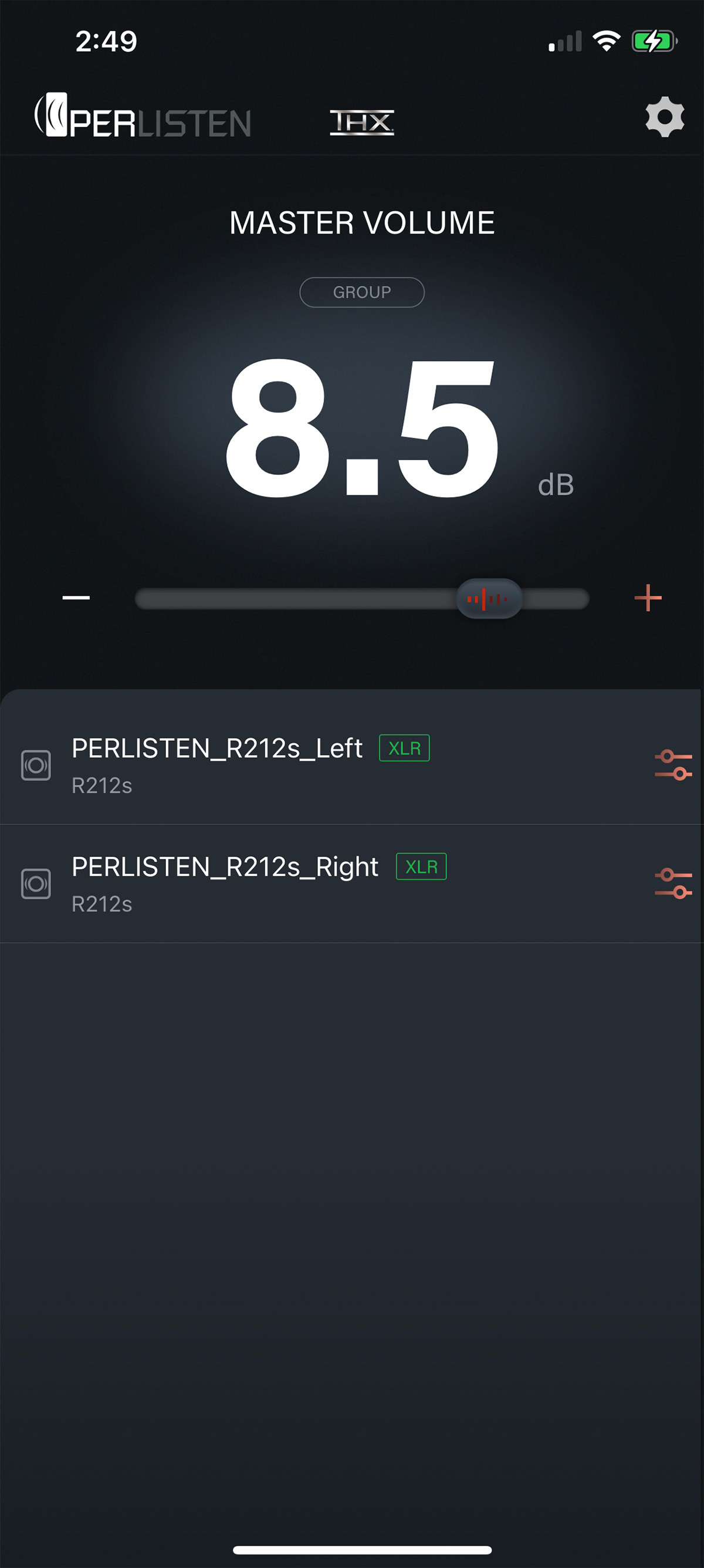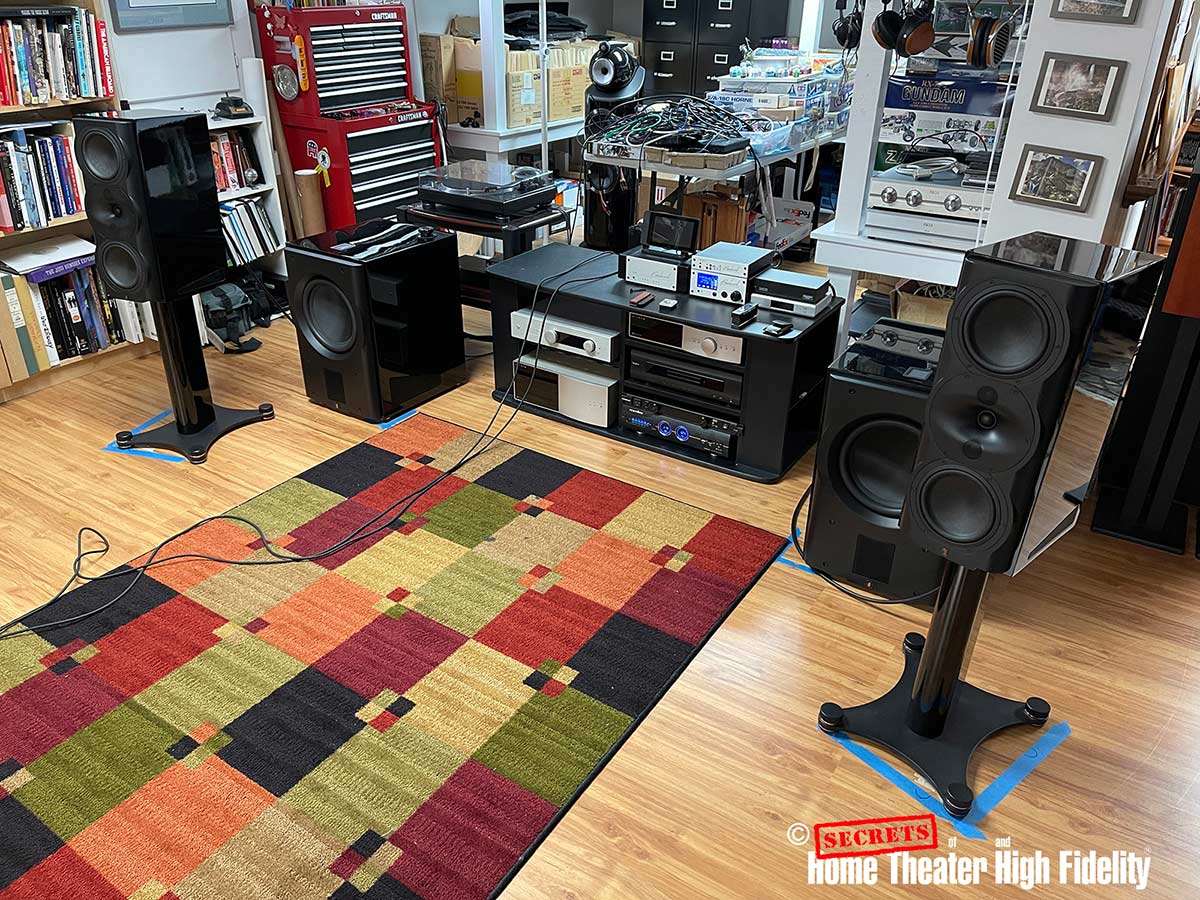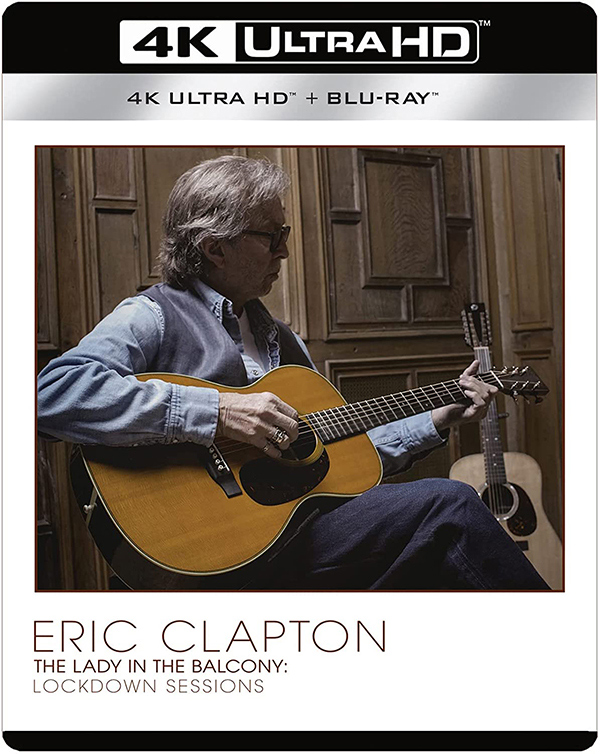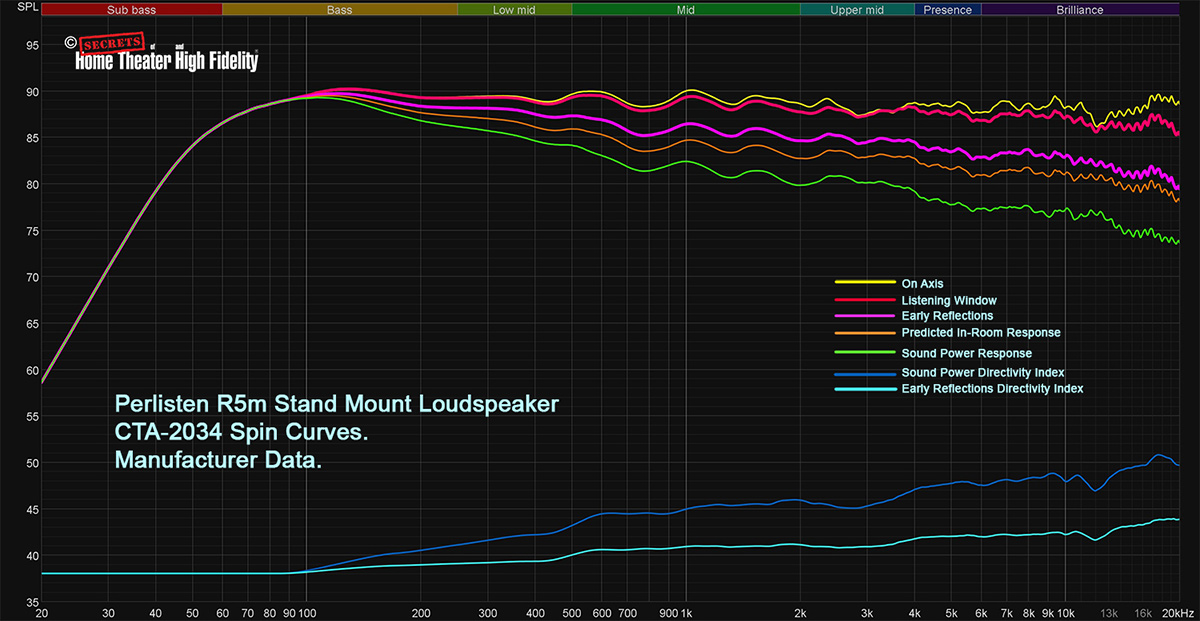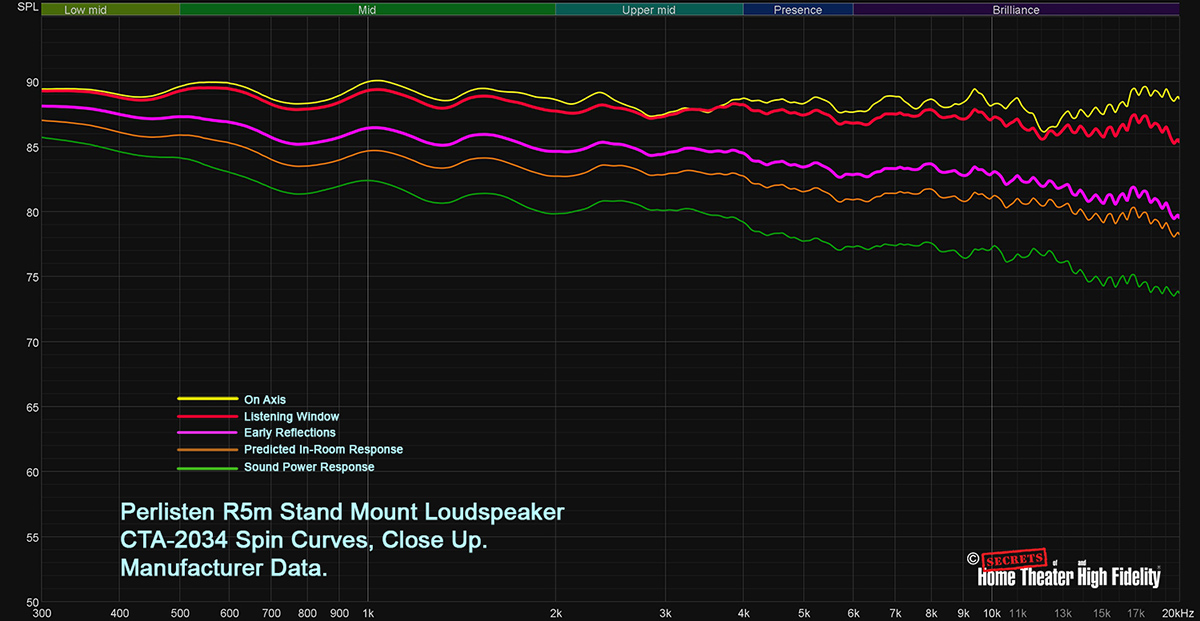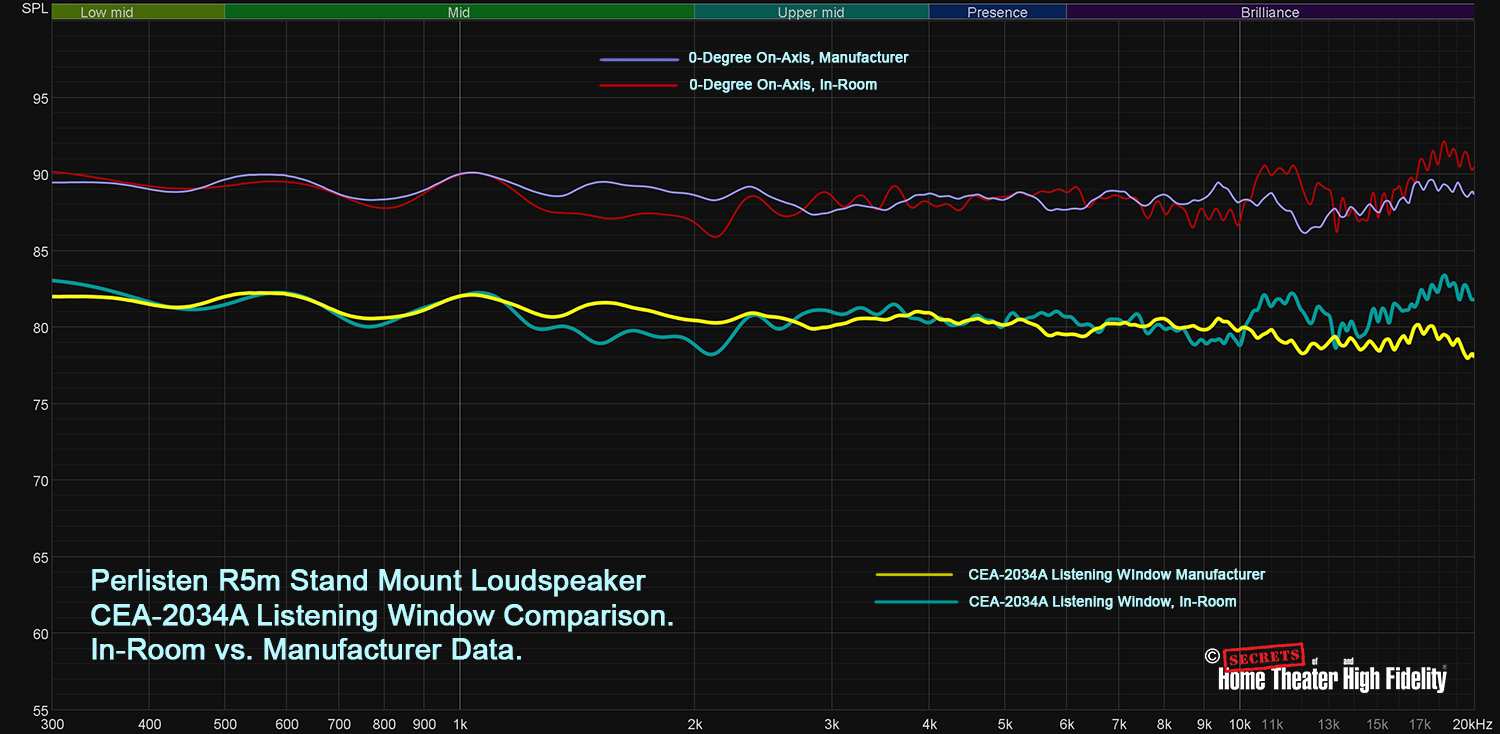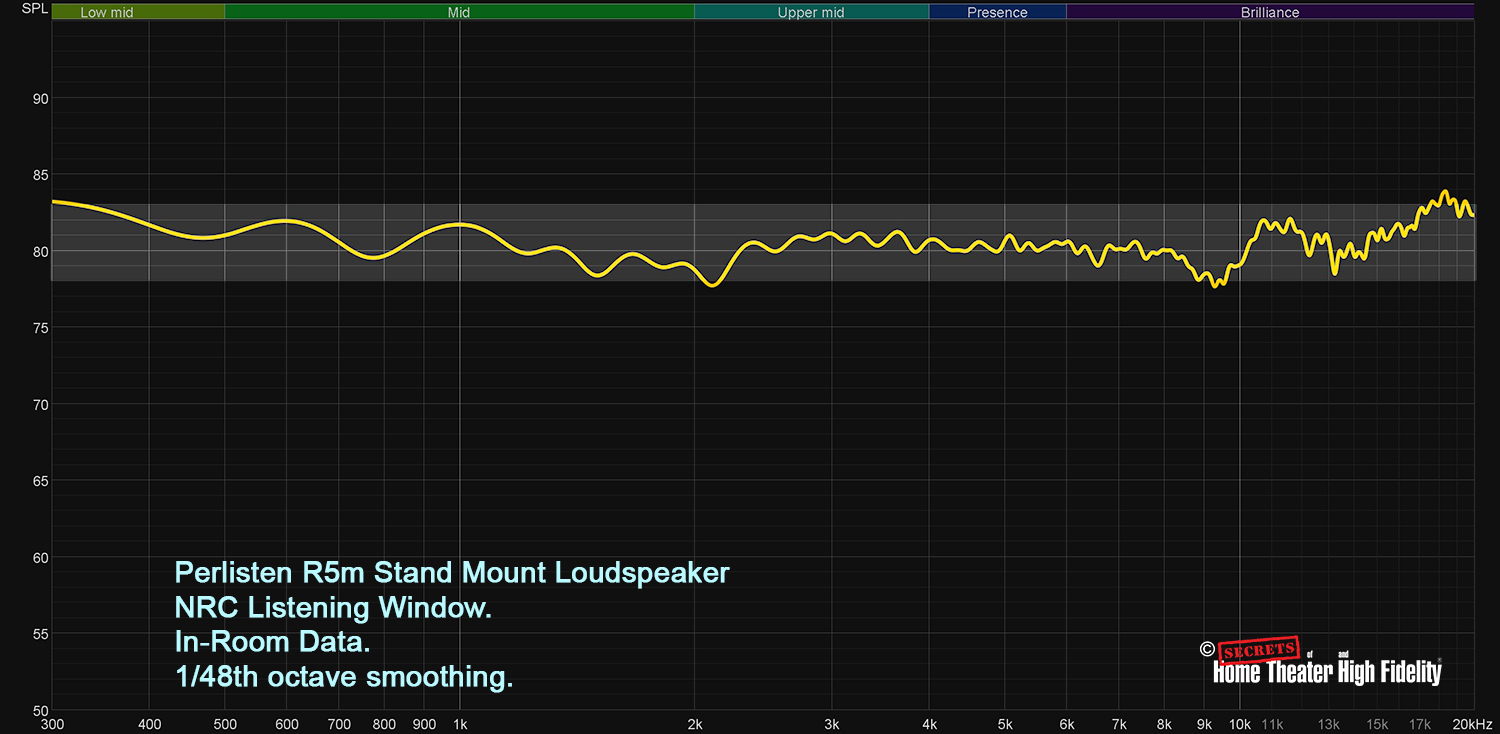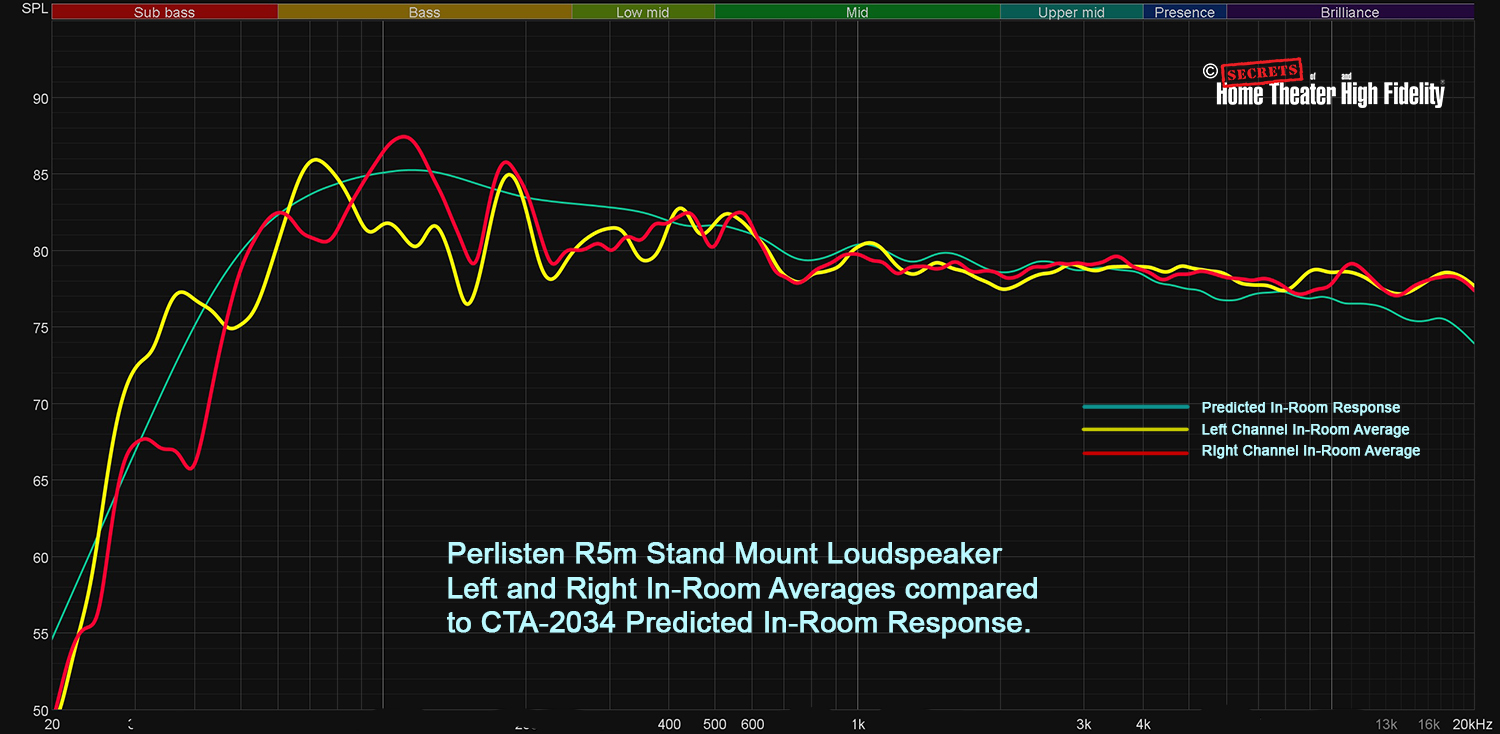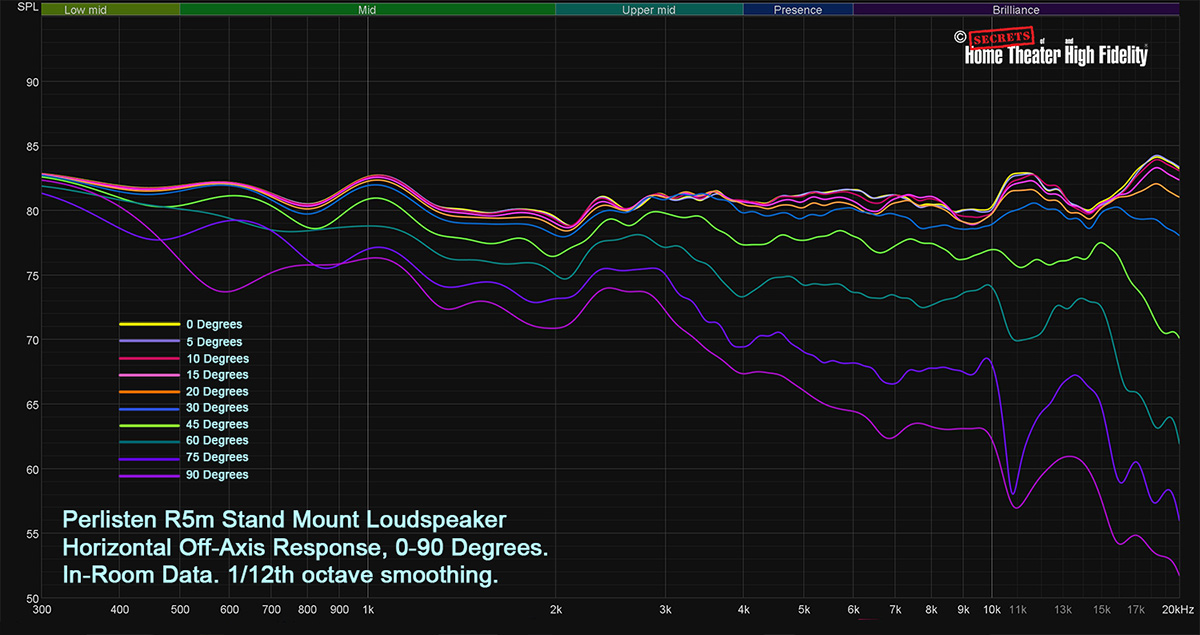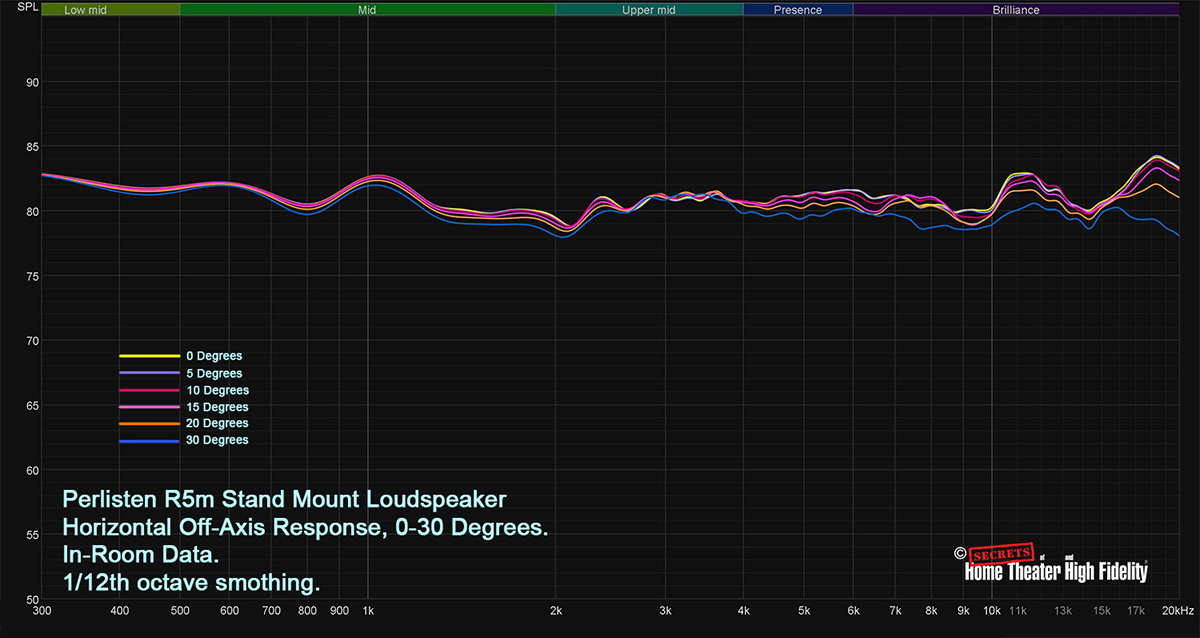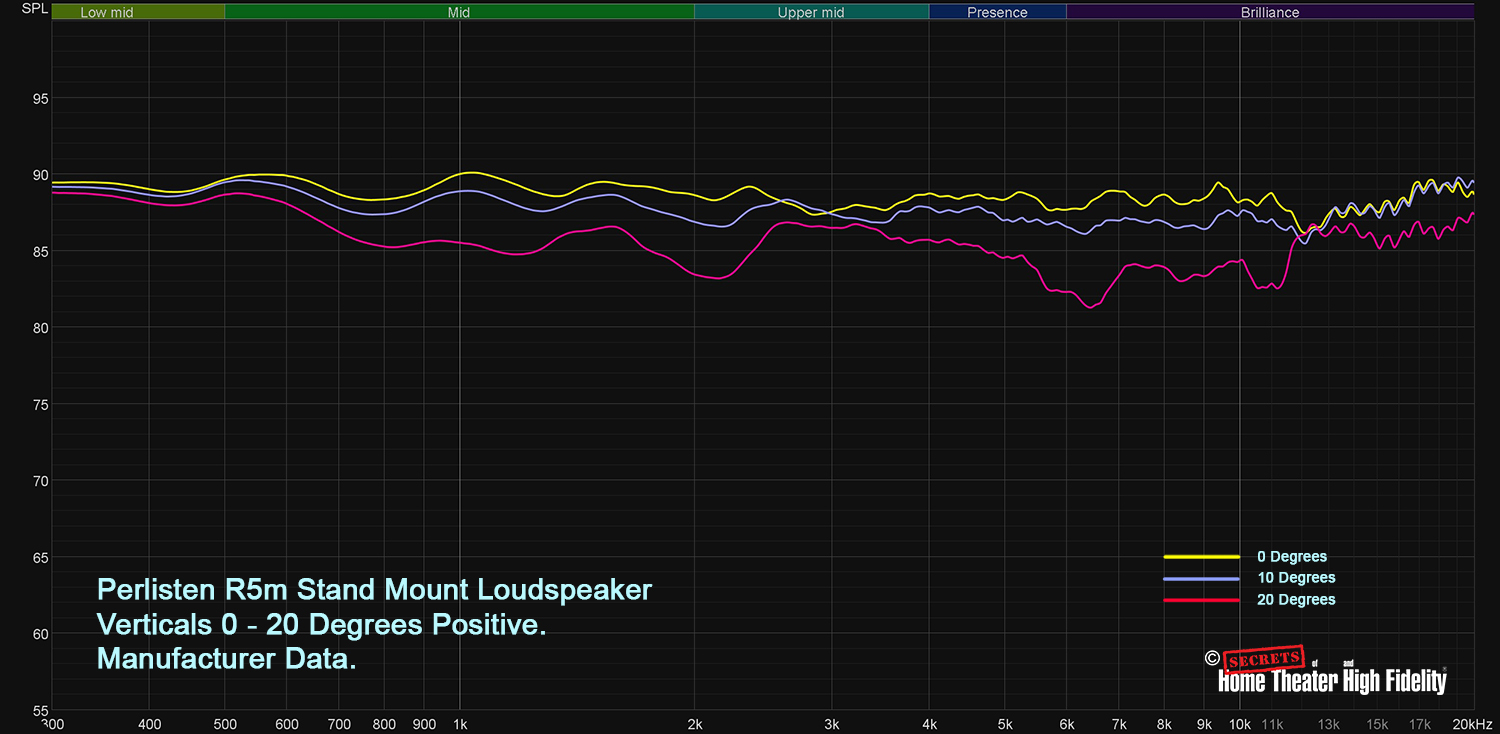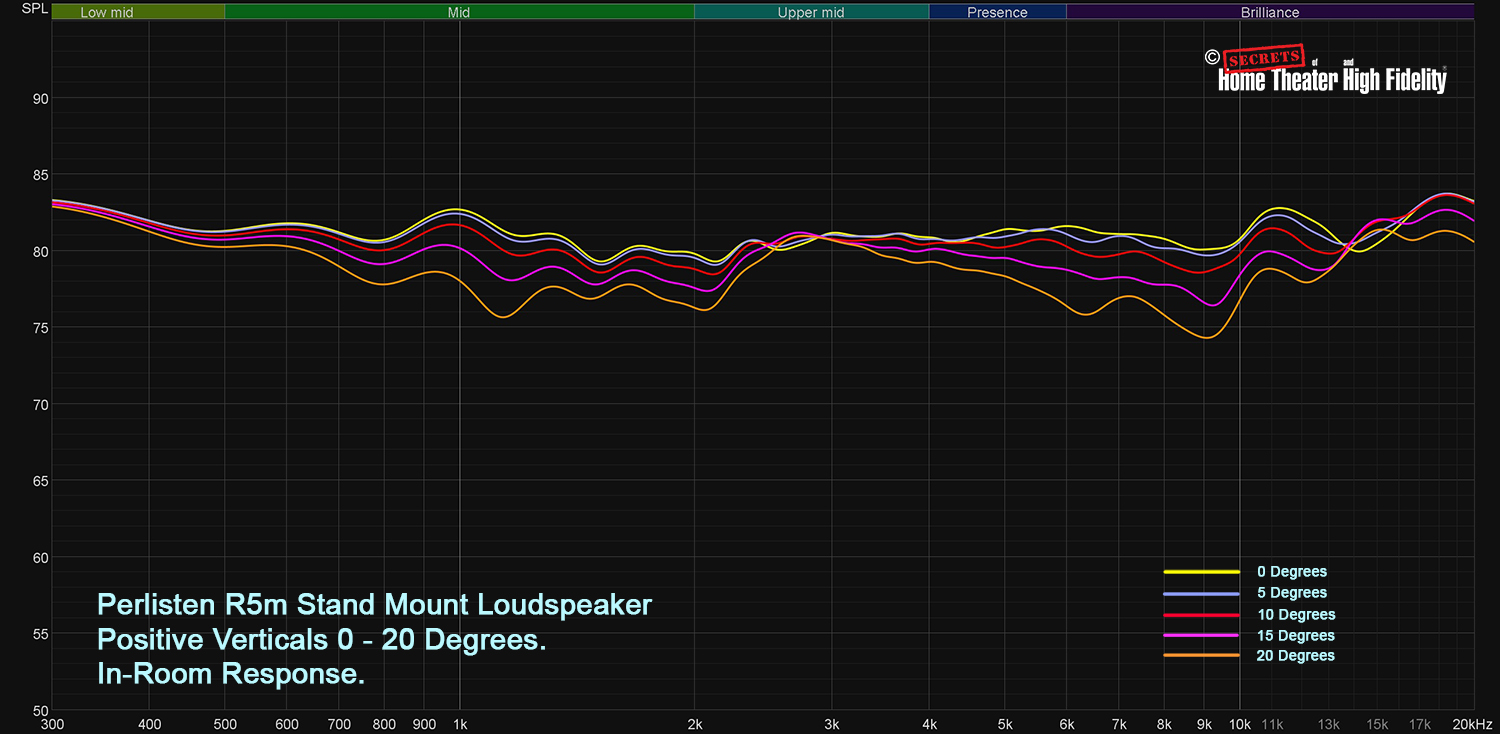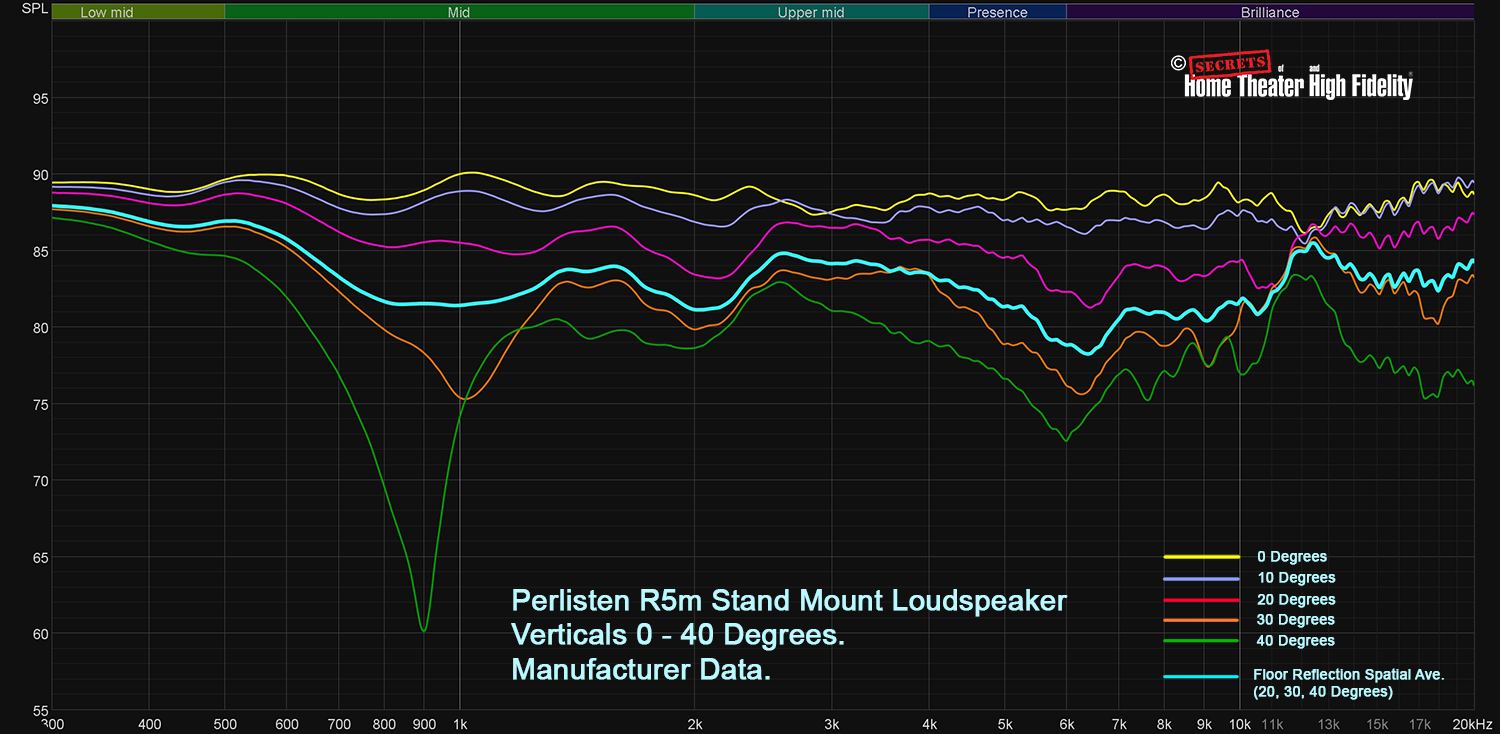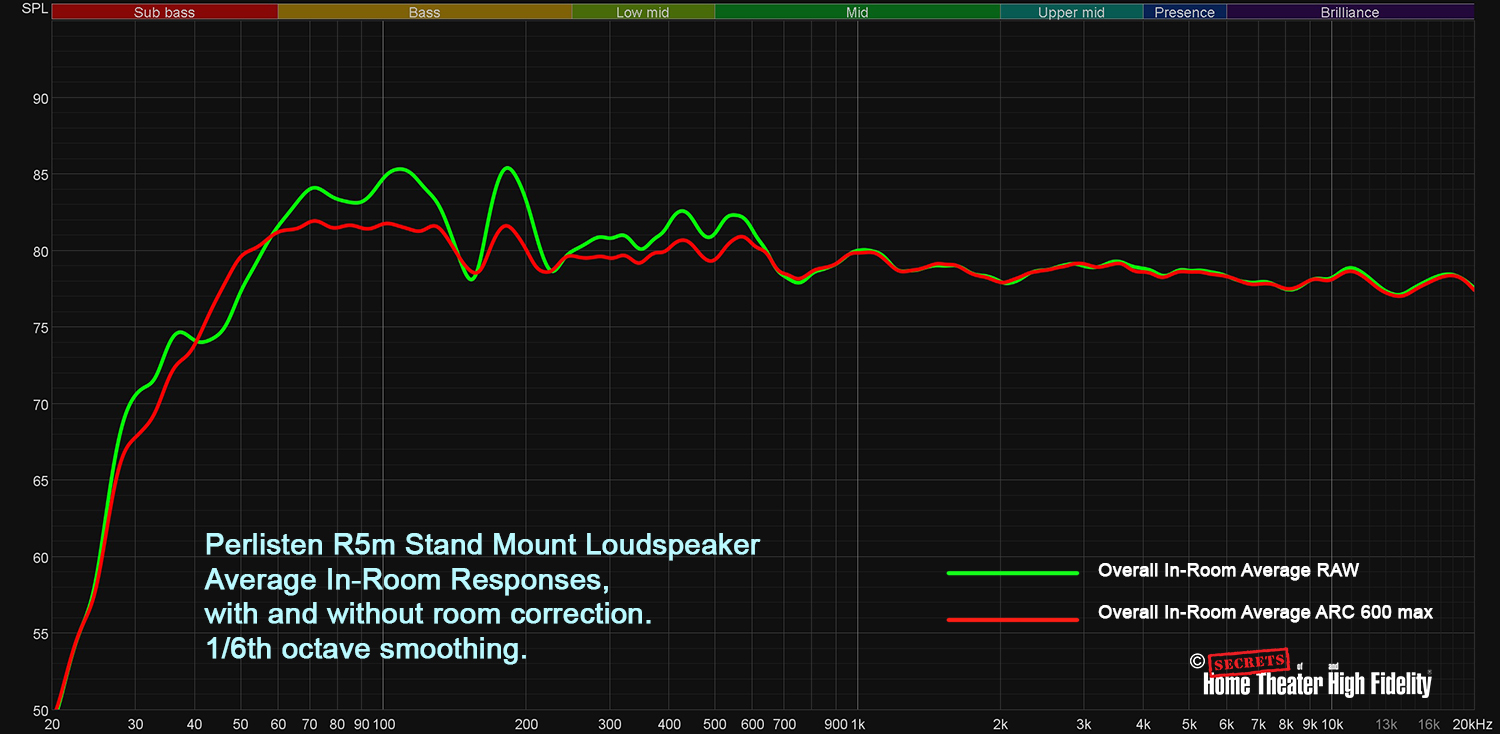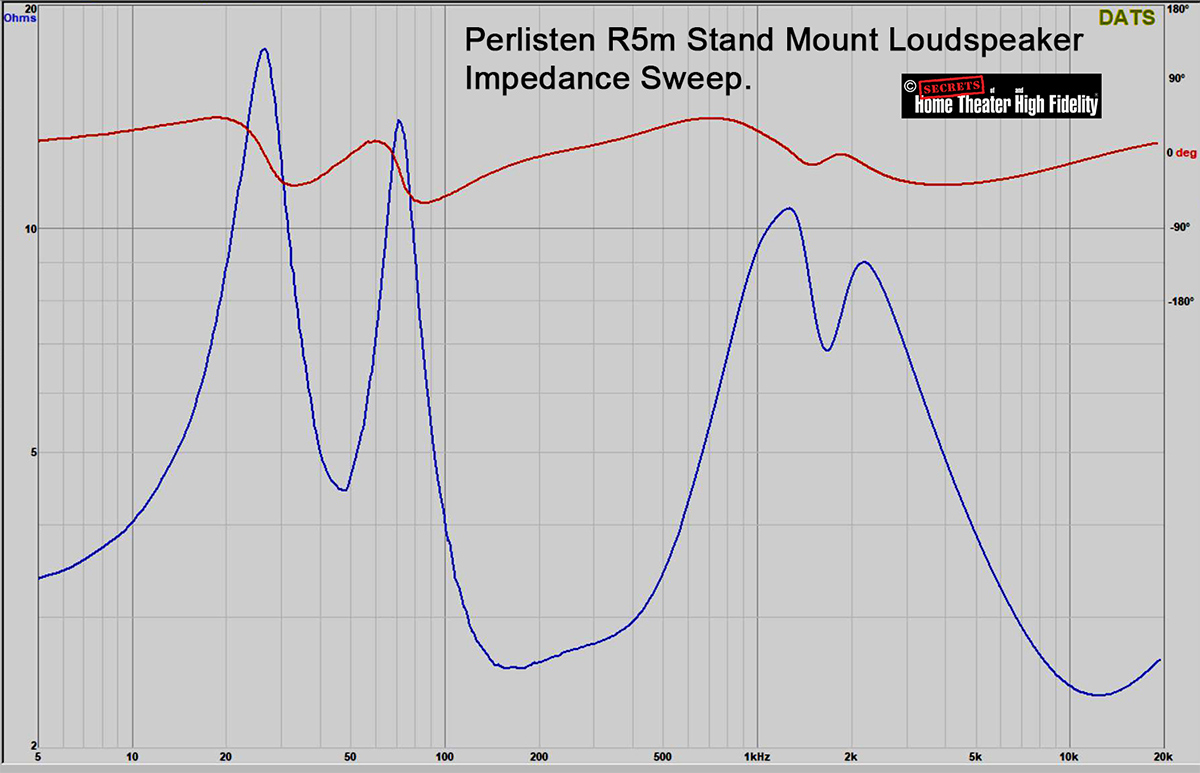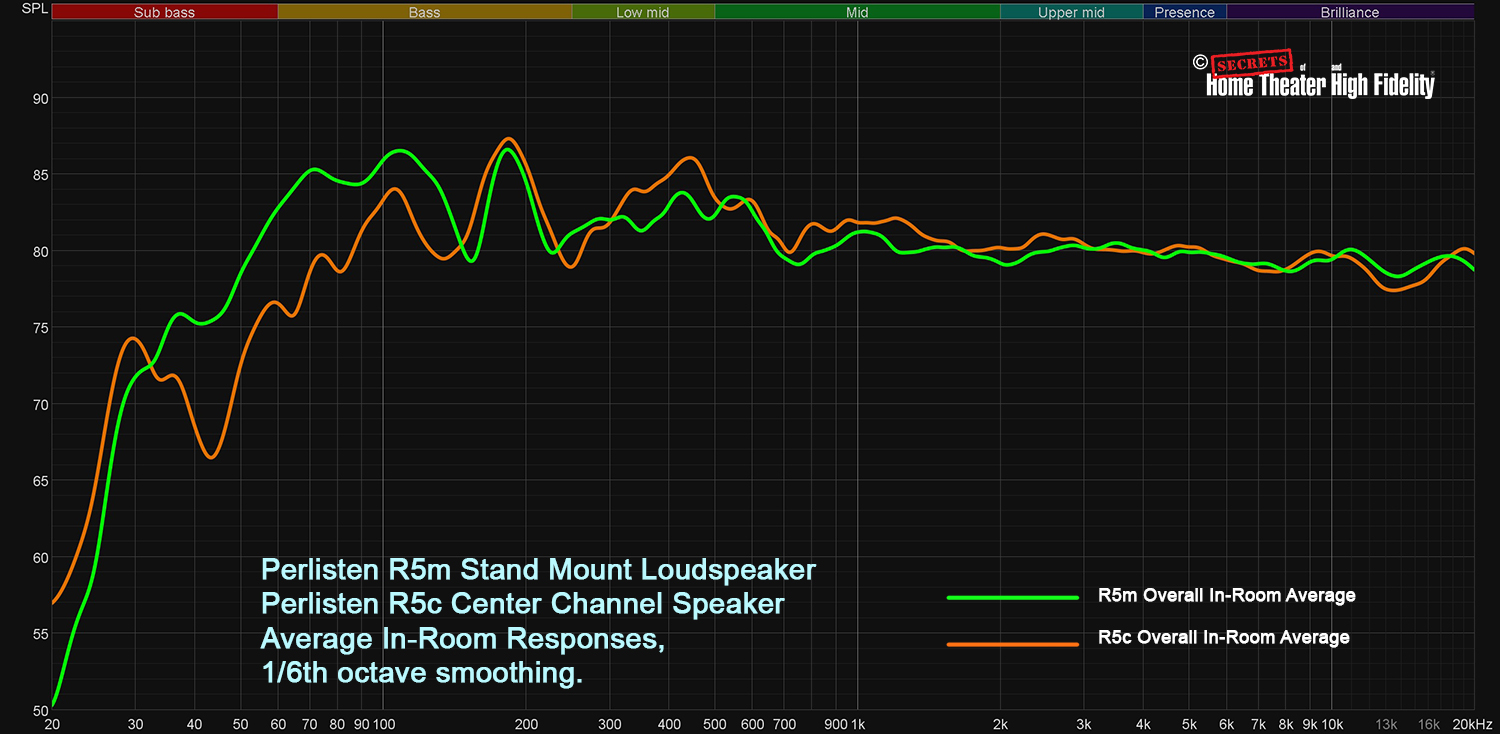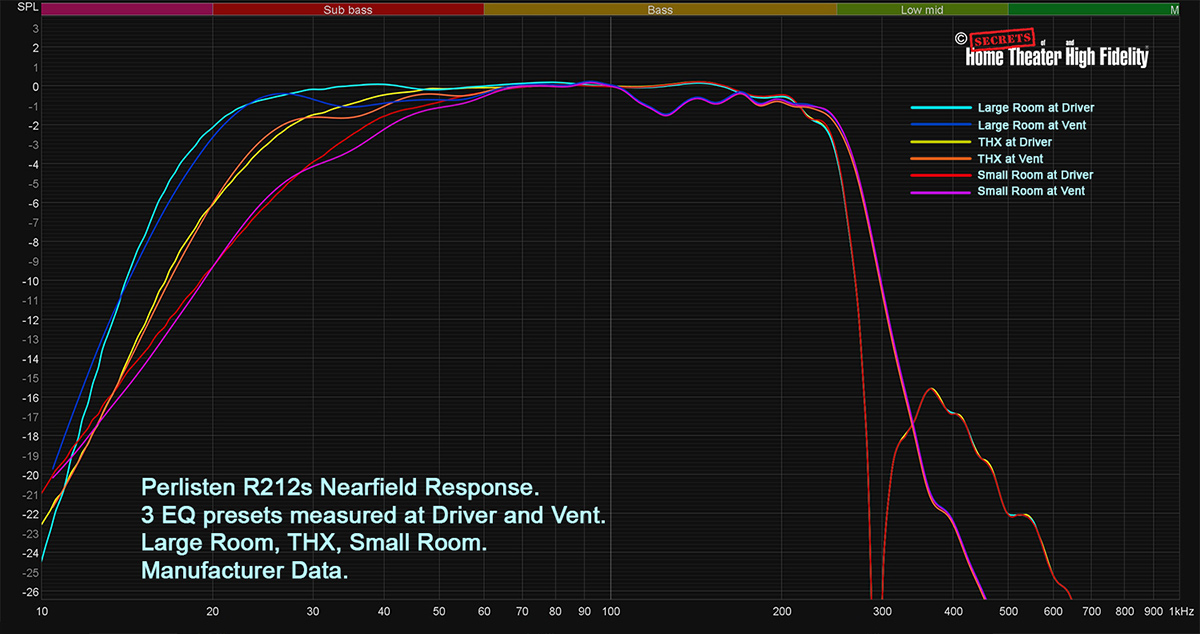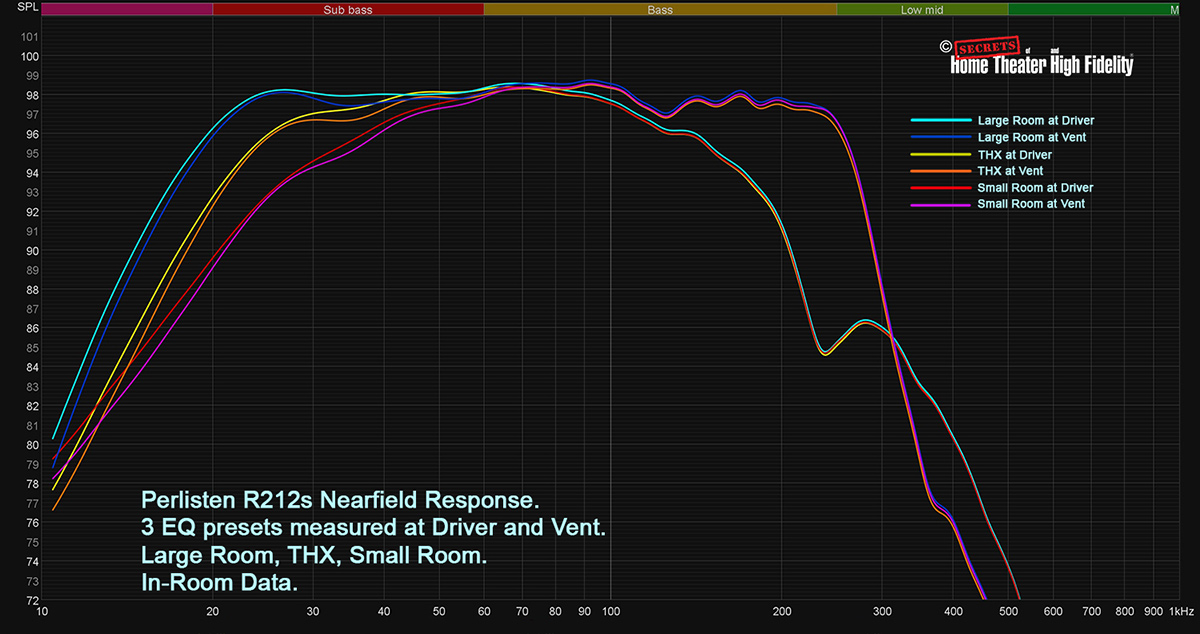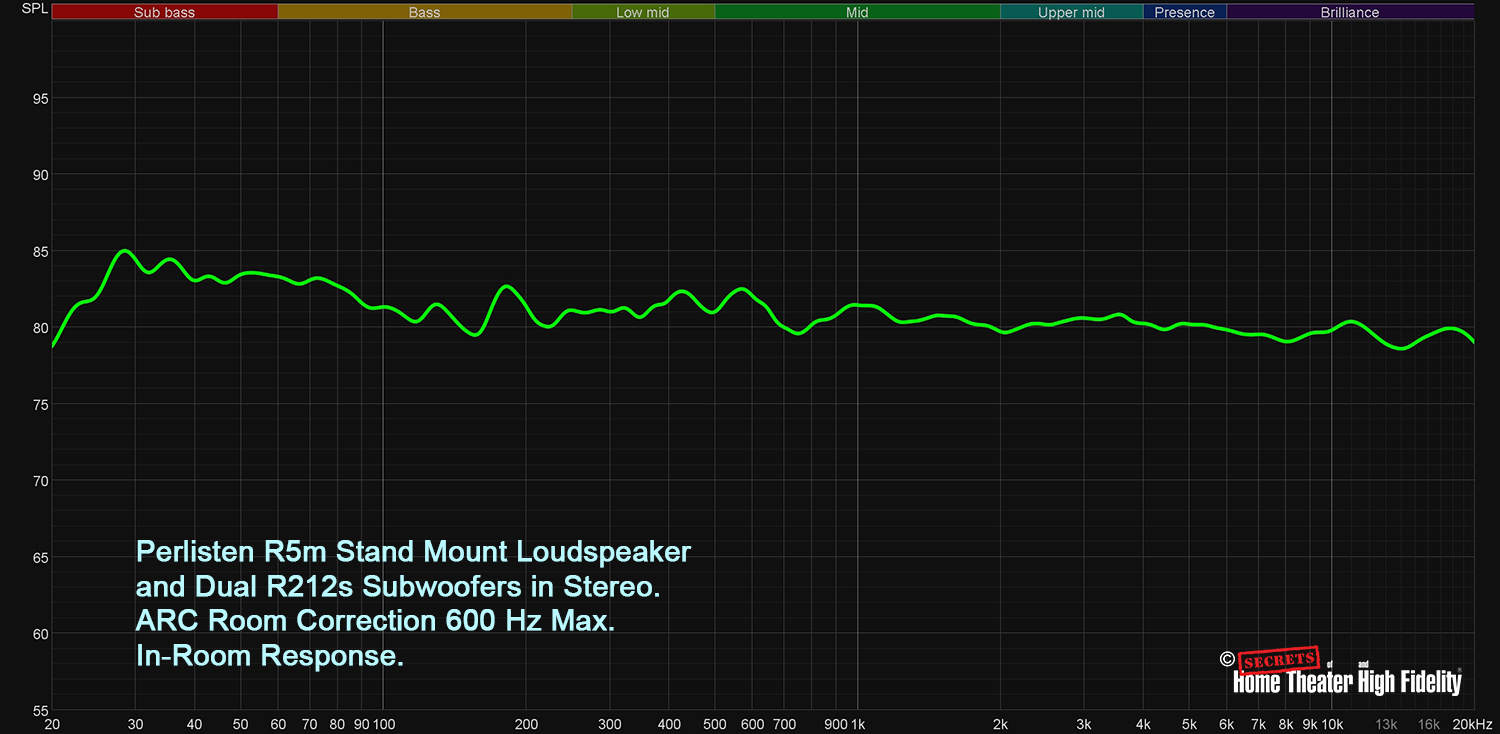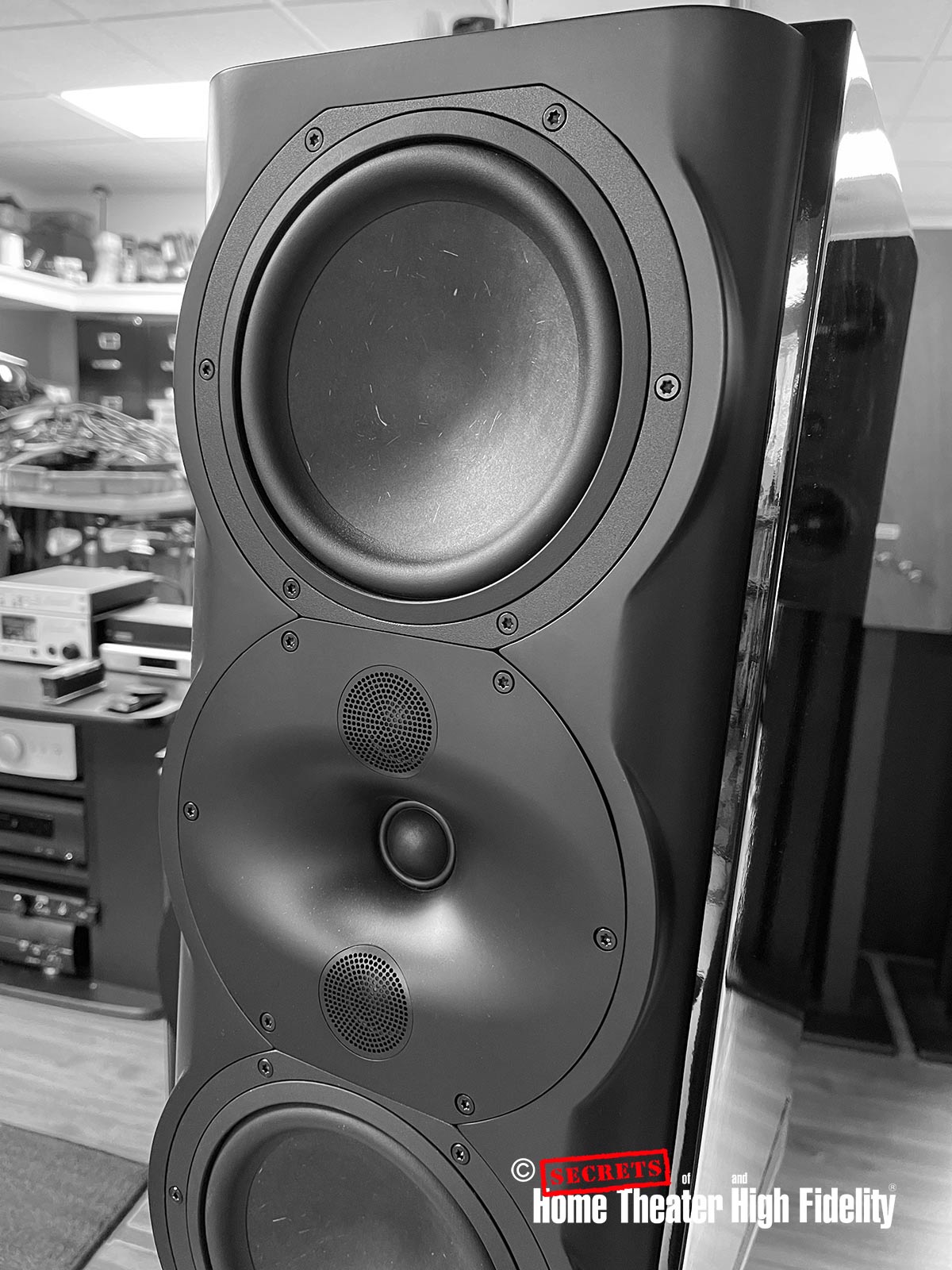Perlisten Audio pulled off a full-frontal assault on the Hi-Fi world last year with their S-series line of loudspeakers and D-series subwoofers, winning universal high praise for both the sound quality and the technical innovations of their products. We liked the review system they sent us so much we awarded it our 2021 Product of the Year award and added both the 5.2 system and the S7t tower speakers to our Secrets Recommended Gear list for 2022.
So what then does the company do for an encore? Specifically, a more affordable (and honestly, more rational) encore? Well, the folks at Perlisten decided to send along an R-series system for us to try out, based around the much more modestly sized R5m monitor speakers, the R5c center channel speaker, and the R4s on-wall surround speakers. Bottom octave bass duties were carried out by brand new twin R212s subwoofers. Visually this is the kind of speaker system that would be more at home in more typical medium-sized home theaters. Technically, many of the innovations from the S-series are still found in the R-series too, just scaled down and adapted to meet a different price point.
Perlisten Audio R5m-based 5.2 Channel Home Theater System
- All speakers use a similar proprietary driver array, centered within a custom waveguide (DPC Array), just with different drivers in the R-series
- Array results in excellent vertical and horizontal dispersion control
- Woofer driver cones are made from a proprietary pulp fiber blend as opposed to the carbon fiber used in the S-series
- Tweeters used in DPC Array are all special silk domes
- All the speakers and subs are still some of the heaviest and most overbuilt speakers I’ve seen (or lifted)
- The R212s subwoofers use dual 12-inch drivers in an uncommon push/pull configuration with a massive amplifier to deliver incredible impact with low distortion
- The custom subwoofer app is extremely well designed and offers a ton of control
- THX Ultra specification certifies that speakers meet extreme SPL and ultra-low distortion targets in rooms up to 3000-cubic feet with up to a 12-foot viewing distance
- Still, some of the best, most dynamic, yet cohesive sound that I have experienced in my home theater. But now more approachable and scaled down in size
It was obvious that we here at Secrets, along with several other audio journos out there on the internet, were both taken by surprise and impressed with Perlisten’s arrival on the scene last year. Taken by surprise because we’ve all heard lofty marketing claims by new companies introducing products before. Honestly, the “grain of salt” you take with such claims these days, has somewhat morphed to the size of an average boulder. We were impressed because Perlisten wowed us in our review of their S7t-based home theater system and by and large, legitimately made good on their claims. Even my colleague and co-conspirator on many loudspeaker reviews, Dr. David A. Rich (a notorious objectivist and scholarly aficionado of classical music) was left agog at the measured performance of the Perlisten S7t towers in my very difficult room. I wasn’t kidding at the time when I said that the S7t and their novel Directivity Pattern Control Array (DPC) were able to bend my room to their will from 300 Hz on up. I hadn’t seen or heard anything like it before from another loudspeaker that wasn’t using DSP or room correction. Now, this was a very premium and expensive system, so the only thing left to wonder was, what could Perlisten do to bring these technological benefits down to a price point that someone like me could afford? Well, an email from Perlisten CEO, Dan Roemer, provided an answer. A new 5.2 channel system comprised of a pair of R5m stand-mounted monitors, an R5c center channel speaker, two R4s wall-mounted surround speakers, and a pair of yet-to-be-released R212s subwoofers. This system shares the same DPC Array and many of the same design elements and tech from the S-series but incorporates different drivers and crossover components and a much smaller footprint. I got a chance to play with the full system set up in my home theater space and as a 2.0 and 2.2 channel system in my more unforgiving studio listening space. Let’s see if Perlisten has caused lightning to strike twice with the R-series.
Secrets Sponsor
R5m Monitor Speaker
Description:
3-way bass-reflex/acoustic suspension stand-mounted loudspeaker with down-firing port
High and Mid-Frequency Drivers:
Three 26 mm silk domes integrated with a custom waveguide
Low-Frequency Driver:
Dual 165 mm HPF pulp fiber bass drivers
Frequency Response (-10 dB):
Bass reflex (ported): 40 Hz-32 kHz (Manufacturer)
Acoustic suspension (sealed):
47 Hz-32 kHz (Manufacturer)
Nominal Impedance:
4Ω nominal / 2.7 Ω min
Sensitivity:
89.2 dB (2.83 Volts @ 1 Meter)
Recommended Amplifier Power:
100-250W RMS
Available Finishes:
Piano black
Dimensions (H x W x D):
21.5 x 9.0 x 13.2″ (546 x 230 x 336mm)
Net weight:
17.5 kg (38.5 lbs.)
MSRP:
$2,995/each; Bespoke stand sold separately, $1,295/each
R5c Center Channel Speaker
Description:
3-way Acoustic suspension loudspeaker
High and Mid-Frequency Drivers:
Three 26 mm silk domes integrated with a custom waveguide
Low-Frequency Driver:
Dual 165 mm HPF pulp fiber bass drivers
Frequency Response (-10 dB) / Acoustic suspension (sealed):
49 Hz-32 kHz (Manufacturer)
Nominal Impedance:
4Ω nominal/3.4 Ω min
Sensitivity:
88.6 dB (2.83 Volts @ 1 Meter)
Recommended Amplifier Power:
100-250W RMS
Available Finishes:
Piano black
Dimensions (H x W x D):
9.5 x 21.6 x 10.6″ (240 x 550 x 270mm)
Net weight:
15.0 kg (33.0 lbs.)
MSRP:
$2,995/each; Bespoke stand sold separately, $650/each
R4s On-Wall Surround Speaker
Description:
3-way Acoustic suspension loudspeaker
High and Mid-Frequency Drivers:
Three 26 mm silk domes integrated with a custom waveguide
Low-Frequency Driver:
Single 165 mm HPF pulp fiber bass driver
Frequency Response (-10 dB):
48 Hz-32 kHz (Manufacturer)
Nominal Impedance:
4Ω nominal/3.7 Ω min
Sensitivity:
86.5 dB (2.83 Volts @ 1 Meter)
Recommended Amplifier Power:
50 – 200W RMS
Available Finishes:
Piano black
Dimensions (H x W x D):
14.9 x 9.0 x 6.8″ (378 x 230 x 173mm)
Net weight:
9.5 kg (20.9 lbs.)
MSRP:
$1,995/each
R212s Subwoofer
Description:
Push-Pull, acoustic suspension subwoofer
Driver Compliment:
Dual 300mm High Excursion Bass Drivers with Glass Fiber diaphragms
Frequency Response (Manufacturer):
THX EQ – 20 – 256 Hz (-6dB) / 16 – 278 Hz (-10dB)
Boost (Large Room) EQ – 16 – 256 Hz (-6dB) / 14 – 278 Hz (-10dB)
Cut (Small Room) EQ – 25 – 256 Hz (-6dB) / 19 – 278 Hz (-10dB)
Amplifier:
1.3kW RMS Short Term
Control Interface:
2.4″ LCD color touchscreen on unit and iOS or Android Smartphone App
Inputs:
(2) Balanced XLR, (2) Unbalanced RCA
Outputs:
(2) Balanced XLR, unbuffered, (2) Unbalanced RCA, unbuffered
Parametric EQ:
10-Band PEQ with 3 user presets
Phase:
Variable 0 – 270 Degrees
Low Pass Filter:
Bypass, 30 – 160 Hz, slope 6, 12, 18, 24dB/oct.
Available Finishes:
Piano black
Dimensions (H x W x D):
23.6 x 16.1 x 19.7″ (600 x 410 x 500mm)
Net weight:
48.2 kg (106.0 lbs.)
MSRP:
$4,995/each
Website:
Company:
SECRETS Tags:
perlisten, speakers, r-series, stand mount, silk dome, dpc, array, surround, home theater
Secrets Sponsor
As with all Perlisten loudspeakers, the defining visual and technical feature is what the company calls the Directivity Pattern Control Array (DPC). The DPC is a specially designed vertical array of three tweeters (all 26mm silk domes in the R-Series) mated to a custom waveguide. The DPC acts as an integrated tweeter/midrange central hub that works, in conjunction with crossover, to ultimately control the vertical dispersion characteristics of the speaker thus helping mitigate floor and ceiling reflections.
The R5m resembles a traditional MTM monitor in layout, with two 165mm specially designed pulp fiber coned woofers flanking the DPC array. As with the previous Perlisten speakers I reviewed, the front baffle is made from a solid High-Density Fiberboard (HDF) block that has been CNC carved to the desired result and securely houses the drivers. The main enclosure is built with 0.75-inch and 1-inch HDF with extensive horizontal and vertical bracing, along with being lined with additional damping materials. Unusually the R5m features a down-firing 3.5-inch port that is partially obscured by the base plate of the custom stand, a pair of which were sent with the speakers. The bottom portion of the R5m has an open cavity with a mesh vent on the bottom of either side and back of the speaker allowing the output of the port to freely expel out of the base of the speaker from multiple sides. The aforementioned stands are as substantial in construction as the speakers. Heavy gauge metal with a thick metal baseplate and adjustable feet, the stands bolt into the base of the speaker with supplied hardware.
All of the R-Series speakers have a single pair of substantial silver binding posts that can handle up to 10-gauge bare speaker wire, along with banana plugs and spades. No speaker grilles were included which was fine by me.
Moving to the R5c center channel speaker, it essentially is a sealed version of the R5m, just turned on its side with the DPC reoriented for center speaker use. The number and type of drivers remain unchanged and Perlisten offers a custom stand for this speaker should you need it. I did not for my review. Like all the other speakers in the set, it felt heavy and well put together, and was finished in a fine piano black finish. I appreciated its more compact size and room correction found the R5c capable enough to assign it an 80 Hz crossover to the subwoofers, consistently.
The R4s on-wall surround speaker probably intrigued me the most as it felt perfectly designed for my home theater use case and it has some interesting features that showed some forethought to the overall design. First was the down-firing angle of both the DPC array and the single 165mm pulp fiber woofer allowing sound to be directed at the main listening area. Next was how the binding posts were positioned close to the top of the enclosure with a generous channel at the top allowing for an easier and more direct cable hookup and the use of heavier gauges of cable. So many of these types of on-wall surrounds that I’ve come across have the binding posts near the bottom of the box and with no thought about how to conveniently run the cable behind the enclosure. They tend to be more of a pain to mount properly in my theater. Not so with the R4s. The third detail that I really appreciated about the R4s was that the entire back of the speaker was covered with a 3mm thick sheet of rubberized material that both kept the speaker from shifting around when mounted and protected the wall from marring or dings from the speaker. I wish more manufacturers who make wall-mounted surround speakers would follow Perlisten’s example here. Subtle genius at work.
And finally, we get to the new R212s subwoofers. They appear for all the world like modestly smaller versions of the D212s subwoofers that I reviewed with the S-Series home theater system. They use the same push/pull driver layout found in the D212s subs, just using two 12-inch Glass Fiber coned drivers instead of 15-inch this time around. Perlisten claims that having two drivers (one oriented perpendicular to the other and with inverted polarity) sharing the same common air volume results in a 10 dB reduction in even-order harmonics. The drivers themselves were completely designed by Perlisten to have a high sensitivity, low mass, low inductance, and low distortion with a very long linear motion. The drivers are powered by a sizeable Class-D amplifier capable of outputting up to 1.3 K Watts of power for short-term bursts. The R212s has a choice of three main EQ presets depending on your room size, Large Room, Small Room, and THX. The THX setting is the recommended preset for most typical-sized home theaters and it’s the setting I used in mine. When I tried the subs in my large studio space, I found the Large Room setting to be more appropriate.
This is all monitored and controlled by sophisticated DSP and accessible by both a small touch screen on the top of each sub for basic settings and an iOS or Android smartphone app for much more granular control. I used the iOS app on my iPhone and found it to be smartly laid out with complete access to both individual subs and global volume as well. There was access to features like 3 different preset subwoofer tunings depending on room size, 10 bands of PEQ with 3 different memories, independent Trim and Crossover settings along with RCA or XLR input control with adjustable gain for each.
All of the Perlisten R-Series speakers at minimum meet the THX Ultra specification (up to 12-foot viewing distance/3,000 cubic foot room) when using them in the way I was planning in this review. If you want to get really specific, the R5m will meet the THX Dominus spec if used as a surround speaker in a larger installation. And where a single R212s sub is THX Ultra rated, duals will put you in THX Dominus territory as well. And finally, the R4s meet the Dominus spec for both surround and height channel use.
Just to recap, the THX Dominus level alone is pretty much a doubling of the limits for THX Ultra. So, for a loudspeaker to meet that specification it has to maintain a very high fidelity of sound at a continuous 85 dB level at the listening position (20 feet away in a 6,500 cubic foot space) with 105 dB peak levels. Subwoofers need to do 95 dB continuous with 115 dB peaks to meet the spec. Both need to accomplish this task while maintaining low levels of distortion, high dynamic range, and proper on and off-axis performance, among other things.
For the 2-channel part of the review, I set up the Perlisten R5m monitor speakers (with stands) in my studio space (35 ft x 23.5 ft x 7 ft) in my typical listening scenario. The speakers were placed about 8 feet apart with just a mild degree of toe-in (5 to 7 degrees). My seating position was 10 feet away from the mid-point of the speaker layout. For stereo listening, I paired the speakers with the Anthem STR Preamp and Power amp combo. This allowed me to leverage the built-in bass management capabilities and ARC Genesis room correction, proving particularly handy when I integrated the dual R212s subwoofers into the mix. Other equipment included my KAB/Technics SL1200 mk6 turntable with Audio-Technica OC9ML/II moving coil cartridge and my DIY ROON endpoint.
For home theater listening, the Perlisten speakers were set up in my smaller home theater room (18’ x 13.5’ x 7.5’), controlled and powered by my Anthem MRX1120 AVR. A note here, while the Anthem MRX1120 AVR worked without issue, driving the Perlisten speakers to reasonable levels for an enjoyable experience, I would strongly recommend using a separate and robust multi-channel power amplifier to get the most out of these speakers. Their impedance drops rather low as you’ll see in the bench test section, so I suggest the more quality power you have on tap to use with these speakers, the better. Other equipment included an OPPO BDP 103 Blu-ray player, a Microsoft XBOX One, my 50” Pioneer KURO plasma display, and 4 GoldenEar SuperSat 3 speakers for overhead ATMOS duty. All speaker cables and interconnect were from Blue Jeans Cable and Clarus Cables.
I started my listening with the Perlisten R5m monitors alone, just to get a sense of how they performed solo in this room. They immediately surprised me with how much bass they put out. The low end was very intense and punchy for a stand-mounted MTM-style monitor, placed well out into the room no less. After trying out a variety of tracks, I became convinced that there was actually too much bass or upper bass coming out of these speakers. Even after some repositioning I still felt like the upper bass was a bit too bloated. I had a suspicion of what was going on and after breaking out my laptop, measurement microphone, and Room EQ Wizard software, I confirmed that the R5m were exciting a room resonance right around 110 Hz with a large and unnatural peak in the response. I’ll usually get a minor bump at that frequency with the right channel in most speakers that come in here but it’s usually not a problem. On rare occasions, I’ll get a speaker or sub in here that will significantly aggravate that frequency. I don’t know what it is about the specific speaker/room interaction combination that causes a peak that large, but it was happening here and now, and it was audible. Given my limited positioning options in this room, it left me with one option to remedy the situation, room correction. So, after a few more measurements and engaging Anthem ARC Genesis room correction with a maximum limit of 600 Hz, the room resonance peak was thoroughly banished. As a note, the R5m did not exhibit this peak when I moved them to my home theater room or when trying them out in the upstairs living room.
Now, this is more like it! The R5m very much exhibited the same midrange and treble balance that I enjoyed with the S7t allowing vocals to image precisely and with a natural body to their tone. This was confirmed when I played some familiar tracks from Paolo Conte’s “Best Of” CD and Holly Cole’s “It Happened One Night” CD. These have become go-to discs for me to assess male and female vocal reproduction as Conte can sound nasal and Cole can sound thin and peaky when the midrange to treble balance is off. I was initially concerned about this since the R5m uses different dome tweeters for the DPC Array and if the transition from the domes to just 2 woofers would cause any issues compared to the S7t that had spoiled my ears previously. Well, I shouldn’t have worried about it. Paolo Conte’s vocals on “Sotto le Stelle del Jazz” had that wonderful gruff and grizzled body to them with a nice sense of depth that I look for. The brushwork on drums that runs through much of the song had great detail to its sound as well, and it didn’t devolve into a variable “shushing” sound as I’ve encountered on some lesser speakers.
Those silk dome tweeters seemed to be doing their thing almost as well as their carbon and Beryllium counterparts did, farther up the product line. The acoustic bass and lower register piano notes also showed that, even with room correction, the R5m has enough bass reach that probably could satisfy many listeners with average size spaces. I experienced an excellent sense of weight in both instruments when listening to this track.
Moving to “Get Out of Town” and “Train Song” from the Holly Cole CD, her voice sounded clear and melodic with a level of weight and body to it that I find extremely pleasing. Whispers and other low volume vocal passages were relayed with plenty of detail so nary a word was missed nor the emotion behind it. The piano on “Get Out of Town” was different from the Conte track, with more upper register notes that were lighter and had a more distinctive ring to them from the live recording venue. Each note was almost bell-like in nature, with the decay of the notes floating in space around me before eventually disappearing. The R5m gave a clean and clear presentation of all of that along with nice, meaty-sounding bass plucks that had surprisingly weight to them. The R5m don’t put out the largest soundstage I’ve ever heard. I ended up positioning them about a foot closer together than my usual Revel F228Be towers, and that helps to really lock the center image in place and make the most of the speaker’s horizontal staging. “Train Song” really allowed the Perlisten R5m to give me a good sense of the live stage with the sound of the atmospheric guitar effects and backing percussion reverberating within the recording space. Again, not an exaggerated sense of space but it certainly does sound “alive” with this kind of material.
Shifting to a little dose of classical music, namely film scores, my SACD of the ‘Classic Film Scores of Bernard Herrmann” is chock full of great film music moments from the iconic composer and is an excellent reference disc for both stereo and multichannel playback. I am very familiar with how this content is supposed to sound in this room and during the initial setup phase with these speakers, I found that I had to position the Perlisten R5m a little closer together than normal in order to lock in the imaging and soundstage properly for this music. Listening now to the track “Descending – The Undersea Forest” from the film Beneath the 12 Mile-Reef was an auditory delight. There are nine orchestra harps deployed on this track and if you can imagine all of them arrayed in a semi-circle in front of you, the first one begins to play a glistening array of notes on the left side, as if mimicking the gentle flow of water. Then, one after another, each harp enters the picture playing a similar flow of notes, almost like a curtain of music unfurling from left to right with a distinct perception of depth as well. The R5m image this musical illusion perfectly with all the detail and spatial cues I could ask for. I could pick each one of the nine harps precisely as they were being introduced into the picture. I’m always surprised at how deep the lower registers of harp notes can get and at the end of this piece I could really feel those lower notes well through the R5m as they were dramatizing the depth of the ocean.
This intense undercurrent of bass continued into “The Octopus-Homecoming Medley” where the low register harp notes were joined by deeper horns, bass drums, and double bass. These instruments gradually combine together to create a sweeping musical mass that circles between and around the speakers with increasing ferocity. The Perlisten R5m did an excellent job at recreating the scale and weight of this writhing musical morass without obscuring the details of the more delicate harp flourishes, and the sounds of the bows and drum mallets being handled. The music then opens up into a bright and lively, full orchestra fanfare, with horns and strings and all sorts of percussion incorporating serious dynamics. The R5m doesn’t get phased at all by this sudden change and expands the soundstage to suit while still allowing me to easily place every instrument section precisely in space. Again, these Perlisten speakers may not image quite as wide as the Revels I have here, but they image wide and naturally enough to make an orchestra sound suitably grand.
Speaking of the Revels I was actually surprised that, at least subjectively, the Perlisten R5m had a similar bass reach in my room. And with the technology behind the DPC array, I was curious to see how the two speakers compared to each other tonally. To that end, I decided to do a little “listening in mono” experiment. I set up one R5m and one F228Be next to each other in the center of my room and used Anthem ARC Genesis to calibrate each speaker from 600 Hz on down. One speaker was assigned the signal from XLR 1 input and the other, XLR 2 so that I could switch instantly between inputs via remote. The left XLR output of my OPPO BDP 105 was connected to the XLR 1 input of my Anthem STR preamp while the right OPPO XLR output went to the XLR 2 input of the Anthem. I then had a number of mono music snippets that had been looped and compiled with the help of Dr. David Rich on a USB drive that I could play through the OPPO and switch between the two speakers to help understand any differences in tone between them. The mono tracks are similar to what HARMAN uses in some of their testing and evaluation routines and are looped snippets of various pop, jazz, rock, and classical recordings, some with male or female vocals too. After I level-matched the speakers, I started listening to the mono tracks and quickly began switching between the Revels and the Perlistens.
It quickly became clear that the Revels threw a wider image than the Perlisten R5m did, which explains my preference for a slightly closer spacing with the Perlisten speakers in stereo. Conversely, however, the Revels tended to make vocals and some instruments sound strangely “tall” whereas the Perlisten was far more of a point-source presentation with vocals and instruments being centered to the speaker. You may read that and think, well “Duh, it’s a monitor versus a tower speaker so why wouldn’t it be like that?” Yes, but it’s one thing to look at the speakers and conclude that fact but it’s another thing to hear the difference back-to-back. It worked the same way with the Perlisten S7t tower speakers that I reviewed as well, and I liked that method of sound projection/presentation. Overall detail and tonality were very similar between the two speakers with the Revels having a touch more “zing” to cymbals and similar instruments, but the Perlisten wasn’t what I’d call soft by comparison either. Just slightly more relaxed.
I had no issues with the sound of male or female vocals on either speaker. Maybe a bit of a nod to the Perlisten more for the central presentation of the vocals versus more of a vertical stretch to them on the Revels. A couple of vocal snippets sounded a bit warmer and more cohesive on the R5m because of it. The two classical mono tracks I had, more than the other genres, highlighted the differences in imaging width between the two speakers. In mono, the Revel’s sound was broader with a touch more perceived depth, with the R5m’s sound remaining more centered to the speaker and less diffuse, but the clarity and detail of both speakers were quite comparable. That narrower sense of image width would explain why I needed to place the R5m a little closer than usual when listening in stereo. The bass output on the R5m alone continued to surprise, hitting with authority, and subjectively not giving much up to the F228Be at all.
Now, having acquired a decent understanding of the speaker’s sound character, I brought the twin R212s subwoofers into the studio to create a 2.2 channel system to see how that would fare. Using the Anthem STR preamp’s bass management and room correction capabilities, I was able to blend both the monitors and subwoofers together with stereo bass. The results were nothing short of outstanding. The dual-driver, push-pull design of the R212s subwoofers provided an unyielding supply of tight and authoritative bass whenever the situation called for it. And by just “juicing” the overall bass level by 2 dB, it brought almost stupid levels of fun to certain bass-heavy electronica and rock tracks! The blending between the Perlisten R5m and the R212s was seamless using the Anthem, but it should be noted that the R212s have a very comprehensive set of PEQ, phase, input sensitivity, and other adjustments that can be accessed through the custom app if you choose to blend the subs in with speakers manually. The latest version of REW also allows for calculating PEQ data for the Perlisten sub as an added bonus.
Playing tracks like Ghost Rider’s “Make Us Stronger” was just an onslaught of bass bliss from beginning to end. Both subs rendered solid, gut-punching impacts, over and over without the slightest protest, energizing a very large room with ease. AC/DC’s classic “Girl’s Got Rhythm” from Highway to Hell came very much alive with this 2.2 channel combo. The R5m handled Angus Young’s guitar work and Bonn Scott’s vocals with great precision and depth, while the Dual R212s pounded out the kick drum hits and electric bass lines. What made it so enjoyable was that I could feel all of that powerful bass energy while still being able to follow the various pitch changes and not have those details obscured. In a room like my studio space that tends to “eat” all the bass at 20Hz, having two subs capable enough to muscle through that while not sounding loose or sloppy at any point is a wonderful addition to my music chain. Obviously, the R5m alone is not in the same league as the S7t that I previously reviewed. There are several things by nature of the S7t’s design that the R5m cannot match from a performance standpoint. But, mating a single or pair of the R212s subwoofers to the R5m monitors can get you a large slice of the tower’s sonic fun factor and might actually be preferable for certain installations.
Moving the speakers and subs to the home theater, it was time to check out how the Perlisten’s performed in surround sound. I started with the “Book of Boba Fett” on Disney+. I use the Xbox One to access our streaming services and it upsamples all audio to Dolby ATMOS. In a multichannel setup, the Perlisten R-series speakers proved to be a very cohesive sounding ensemble. Spaceship flybys and flyovers were seamless and convincing. The R4s surrounds were particularly adept at placing specific sounds around and behind me along with filling in the general atmospheric sounds. The entire combination created a very immersive sonic bubble that put me squarely on Tatooine in the middle of all the action. An out-of-control Rancor sounds pretty amazing on this system!
Eric Clapton, The Lady in the Balcony: The Lockdown Sessions. Blu-Ray, Dolby ATMOS
This is almost like a COVID version of Clapton’s Unplugged album but with different material that he draws from a different palette of experience. The ensemble consisted of guitar, drums, keyboards, and stand-up bass recorded in a reverberant old manor home. The ATMOS soundtrack is well recorded and mixed with lots of the environmental atmosphere and spatial cues coming through. The Perlisten speakers give an exceptionally natural-sounding presentation. They are really superb at relaying all the subtleties in this concert. Clapton’s voice is older, a little more haggard but still expressive, especially on “Bell Bottom Blues.” The Perlisten R5c center-channel speaker really makes it sound so effortless and natural, both with Clapton’s voice and guitar playing sounding tonally proper and clear. The crispness of “Slowhand’s” fingerpicking just sounds delightful and even the slightest brush or bend of the strings comes through. Steve Gadd’s subtle, tasteful brushwork on the drum skins comes through very clearly in the right channel where it might not otherwise be in lesser speakers. The Perlisten’s actually allowed me to make out the circular sweeping motion of his brushwork in space with my eyes closed. The performance is set up like a casual jam session (casually set up in a castle hall mind you, but whatever) and I love the natural banter and chit-chat between the band members.
“After Midnight” just sounds exceptional with Nathan East’s stand-up bass opening the track. The dual subwoofers are nowhere near being taxed here, but what they are doing is providing a wonderful clean recreation of that bass intro. Tight, detailed, and pitch-perfect. A lovely sounding textural foundation for everything else. And Chris Stainton’s keyboard work (mostly in the left channel) sounds so smooth and clear, particularly as a counterpoint to Clapton’s guitar in the acoustic version of “Layla.” The Perlisten R-Series speakers will do explosions, wild effects, and subterranean bass all day long but what they also excel at is the far more subtle and sublime stuff as in this concert. During the whole performance, the Perlisten speakers put me squarely in that castle grand room and I was totally immersed in every facet of the sonics of the space. A superb acoustic illusion.
Ghostbusters Afterlife, Blu-Ray DTS HD Master Audio
I loved the original Ghostbusters as a teen and this was the perfect sequel/follow-up to those first two movies. The Perlisten speakers excelled at recreating the whole array of ghostly and disembodied spirit effects that swirled around me at various scenes in the movie. The dialog was always clear and intelligible through the R5c center channel amid layers of effects sounds from the same speaker. The R5c maintained that performance and clarity when listening decently off-axis too. The R212s subwoofers pounded away at all the explosions, proton packs firing, ghost traps opening, earth tremors, you name it. One subwoofer would have probably been enough in my room as the two subwoofers weren’t even breathing hard but the bass sounded tight, solid, and evenly distributed through the seats which is why you do multiple subs if you can. The on-wall surrounds continued to impress me, effectively creating the whole rear half of the surround audio bubble. And the sound from the surround speakers was not overly diffuse. There was a very good deal of specificity to the sounds moving around and behind me. It was easy to track individual elements in the mix.
Bench tests were performed with a Cross Spectrum Labs calibrated Earthworks M30 microphone connected to my computer workstation using Room EQ Wizard acoustic measurement software and an M-Audio microphone preamp. On and off-axis measurements were taken with the mic at 1-meter from the center point of the tweeter as the 0-degree reference point. Unlike measurements taken outdoors or in an anechoic chamber that measure a speaker in isolation (and assess straight-line engineering), in-room measurements give a sense of how a speaker behaves in the actual environment that it’s used. Both types of measurements are valuable, I just find in-room measurements interesting as they help shed light on what I am hearing and why. That and I don’t own an anechoic chamber!
Impedance measurements were taken using the Dayton Audio DATS v3 loudspeaker tester and software.
All measurements, unless otherwise noted, were taken in my large basement studio space.
David Rich notes: Perlisten was amazingly helpful when it came to verifying our measurements. They provided us with enough examples of their data in the REW software that we used so we could compare how close we were getting with our in-room measurements. Obviously, there was no way for an exact match given the different conditions, but we got notably close in a number of instances.
Above is the spin curve data for the Perlisten R5m provided by the manufacturer and assembled by us in this chart using REW.
David Rich notes: The basics of how to read the CTA-2034 curves are best appreciated by purchasing the Floyd Toole text titled “Sound Reproduction: The Acoustics and Psychoacoustics of Loudspeakers and Rooms”.
The fundamental design criteria for good-looking CTA-2034 curves are that the listening window should be flat. Next, the horizontal radiation patterns should be monotonically decreasing with frequency. As we will see below, the Perlisten speakers satisfy these criteria. For more information on CTA-2034 curves, I send you to Dr. Toole’s text or some of his lectures found on YouTube.
Unlike speakers with spaced drivers and standard crossovers, we do not see much change in the DIs (Directivity Indexes) at the crossover. As we have seen speakers with spaced drivers, the vertical radiation response patterns dip significantly with angles wider than 15-degrees or even smaller angles in some designs. This change in vertical radiation results in a dip in the early reflections and power response.
The Directivity Indexes go up when the power response or early reflections goes down relative to the listening window (assuming it is flat), so we see the Directivity Indexes going up around the crossover with speakers with spaced drivers.
We do not see this effect in the Directivity Indexes in the Perlisten plot since the speaker attenuates the vertical energy off-axis from 500Hz to 20Khz across the frequency band as we will see below. Nothing significant happens around the crossovers between the woofer and midrange array and the crossover from the three tweeters to the single-center tweeter alone.
Above is a close-up view of the spin curve data for the Perlisten R5m provided by the manufacturer and assembled by us in this chart using REW.
David Rich notes: The listening window is flat. The early reflection and power response show almost textbook monotonic slopes.
In this plot, we added the Predicted In-Room Response (PIR) to the traditional curves. This curve attempts to predict the response of a speaker at the listener’s seat. It is a mix of the listening window, early reflections, and power response. You can see it lies between the early reflections and power response. We will compare its prediction with our in-room measurements below.
Note how the PIR slopes down at a rate that academic papers (see Dr. Toole’s book mentioned above, specifically sections 12.2 and 12.3) show it should in order to be subjectively superior in blind listening tests (ignoring low-frequency extension differences). A monotonic PIR with minimal deviation from a linear approximation to its slope is not the only factor in allowing a speaker to achieve a very high double-blind score. The Listening Window must have minimum deviation from a flat line.
To compare, this is a plot of the CEA-2034A listening window for the Perlisten R5m (teal trace) scaled from 300 Hz on up which is averaged from the following measurements: 0-degree on-axis, +/-10-degrees vertical, and +/-10 and +/-20-degrees horizontal. Here, we see it compared to the CEA-2034A listening window response (yellow trace) provided by the manufacturer. Not too far off each other.
David Rich notes: The curves Carlo produced have a depression from 1 kHz to 2 kHz. It is unclear what causes this dip in our in-room quasi-anechoic data which has room reflection coming back to the microphone. The impulse is windowed at 4msec. It appears in the horizontal radiation patterns at 10, 20, and 30-degrees which are used in the listening window calculation.
This is a plot of the NRC listening window for the Perlisten R5m scaled from 300 Hz on up which is averaged from the following measurements: 0-degree on-axis, +-15-degrees vertical, and +-15-degrees horizontal. This is the portion of the frequency range that is dominated by the speaker (response below 300 Hz tends to be dominated by the room and can vary greatly).
David Rich notes: One would expect this to be worse for the Perlisten R5m since its 15-degree vertical response in the NRC average, by design, is not flat, as we will explain below, but it is very similar to the CEA 2034A listening window.
Above are the Left and Right channel In-room averages of the R5m speakers compared to the Predicted In-Room Response (PIR) plot supplied by the manufacturer. The Left and Right averages (even in this tough room) show very good channel matching from 200 Hz on up. Below that the room acoustics dominate and result in some wilder variations in the bass response. Even so, when looked at as a whole, both averages are tracking the PIR fairly well although beyond 4 kHz the PIR is declining a little faster than the speaker response in-room.
David Rich notes: Carlo toed in the speaker by 7 degrees. If the speaker was not angled, the speaker would more closely correspond to the Perlisten’s data for the PIR.
The 500 Hz-700 Hz dip is likely a floor or ceiling reflection. The R5m begins to attenuate these reflections above 700 Hz. More details below on the vertical radiation patterns. The slight dip 1.5 kHz – 2.5 kHz mirrors our listening window but is smaller and less wide.
Above are the horizontal radiation curves from 0 to 90 degrees, scaled from 300 Hz on up, provided by Perlisten.
David Rich notes: Angles greater than 45 degrees show textbook monotonic response. The cause of the peak and dip around 10 kHz is not clear but also appears in our measurements in the next figure.
Note the 6.5-inch driver’s radiation pattern converges to the same value as the frequency descends from 700 Hz. Above 700 Hz the 6.5-inch driver is becoming increasingly directional. At 1.3 kHz the crossover to the DPC occurs. Note how well matched the tweeter array is to the 6.5-inch driver.
The 6.5-inch driver is crossing over at 1.3 kHz. A typical design with spaced drives would use 5.25-inch drivers crossed over and octave higher. The horizontal radiation patterns are thus similar.
Carlo’s comments about a lack of spaciousness in his mono listening comparison are related to what happens above 3.5kHz when the outer domes are turned off and only the center tweeter in the deep waveguide is energized.
We can see the response above 3.5 kHz rolls off more quickly than in a speaker like the Revel F228BE Carlo used for comparison as a result of the deep waveguide. It is only above 3.5 kHz that the speaker would sound less spacious as a result of reduced energy in the room. The trade-off is less uncorrelated reflections from untreated surfaces coming back to the listener.
Note that the highest quality professional speakers designed for mid-field to far-field usage have deep waveguides to control the room acoustics and create the most accurate mix.
The peak and dip around 10 kHz we saw in the Perlisten data earlier, repeats in this graph.
Room reflections make this graph increasingly inaccurate below 1 kHz, however, one can see the DPC is integrating well into the radiation pattern of the 6.5-inch woofer.
Above are the horizontal radiation curves from 0 to 90 degrees, taken in-room, scaled from 300 Hz on up.
Above are the horizontal radiation curves of the Perlisten R5m from 0 to 30 degrees, scaled from 300 Hz on up, provided by the manufacturer.
David Rich notes: We see a convergence of the curves between 3 kHz and 4 kHz. This is the frequency that the outer tweeters are rolled off. Those tweeters are not in a waveguide as is the center tweeter.
Above 4kHz we are seeing the radiation pattern of just the center tweeter. Above 4 kHz any convergence of the on-axis with the off-axis curves past 30-degrees is likely a waveguide reflection.
Above are the horizontal radiation curves of the Perlisten R5m from 0 to 30 degrees, scaled from 300 Hz on up, measured in-room. Looking at the response curves we see, while not quite as smooth as in Perlisten’s own data owing to the reflections in my room, the curves remain uniform and are tightly tracking each other. Noticeable deviation begins at 30-degrees off-axis.
David Rich notes: The drop from 1 kHz to 2 kHz in this curve resulted in the drop appearing in the CEA listening window since the angles at 10, 20, and 30-degrees are used in the calculation. As can be seen above, the drop is not in the Perlisten data.
Again, it is unclear what causes this dip in our in-room data which has room reflection coming back to the microphone. The impulse is windowed at 4msec.
Moving to the vertical radiation pattern for positive angles for the Perlisten R5m, we see the plots for 0 to +20 degrees, scaled from 300 Hz on up provided by the manufacturer. Note this is a fully symmetric speaker. Turn it 180 degrees and you are looking at the same thing. Thus, we only have to look at one set of vertical curves as we look at one set of horizontal curves which are also symmetrical.
David Rich notes: Now we will start to understand the tradeoff between flat vertical response off-axis and reducing early reflections from the floor. Floor reflections, from the CEA 2034 standard, are at 20-degrees, 30-degrees, and 40-degrees. The 20-degree vertical response needs to be depressed as we see here. Even 10-degrees show some depression but are still useable.
Perlisten has developed new, patent-pending, technology, and is using the latest CAD tools to model the DPC and the crossover. Still, they cannot create magic. You want the vertical response to be flat off-axis and you want it down significantly at 20-degrees. Something had to give.
Moving to the in-room vertical radiation pattern for positive angles for the Perlisten R5m, we see the plots for 0 to +20 degrees, scaled from 300 Hz on up.
David Rich notes: This curve is in a finer resolution than what Perlisten provided. It is at 5-degree increments. We see that 5-degrees is almost glued to the on-axis. You want to be +/- 5 degrees from 39 inches which is the equivalent tweeter height with the 2-degree stand tilt. Since the R5m stand allows you to change the tilt you can adjust it for other requirements, such as a multiple-row home theater, but change the height. 2-degrees tilt is the minimum. It can only be increased.
Like the Perlisten plot at 10-degrees, the sound will be dulled. Go beyond 10-degrees and the speaker is transitioning to attenuate the floor bounce. By 20-degrees it has achieved this, but something is happening around 3 kHz. All the curves are converging.
Around 3 kHz the outer two of the 3 tweeters, which reduce the vertical radiation from the 1.3 kHz crossover to the DPC, are being turned off. If they stayed on, the response at 5-degrees would start dropping which we do not want to happen. At 2 kHz – 3 kHz the outer tweeters have turned off and only the central tweeter is on. Unfortunately, that center tweeter is radiating over a wide-angle. The center tweeter is not getting directional until 5 kHz.
You can see the same thing, a little less dramatically, in Perlisten’s data above.
Moving to the vertical radiation pattern for positive angles for the Perlisten R5m, we see the plots for 0 to +40 degrees, scaled from 300 Hz on up provided by the manufacturer.
David Rich notes: The graph extends the vertical radiation pattern to 40-degrees. Recall that 20, 30, and 40-degrees are the three vertical angles that make up the floor reflection in the CTA 2034 data set. The ceiling bounces are at higher angles.
Note the huge attenuation the speaker produces at 30 and 40-degrees. 20-degrees is a little compromised but as we said earlier, at 5-degrees the DPC has a whole other job, to stay as close to the on-axis as possible. What Perlisten achieves in this plot is amazing, meeting the two diverging requirements. No wonder patents are pending. Just an outstanding graph here.
Note at 500 Hz the fun is over. The curves are converging to flat. What is going on? Below the DPC the vertical radiation pattern is set by the two 6.5-inch spaced drivers. The drivers are starting to radiate into wide angles. What is needed is something to stop this. What is needed is another pair of woofers outside the pair in the R5m and that is just what the R7t has. These woofers come in about 600 Hz and slam the vertical radiation response back down. Not until 300 Hz, where the room, not the reflections, dominates the response at the listening position does the vertical radiation pattern of the R7t move to converge to the on-axis amplitude.
The light blue curve is the average of the vertical radiation patterns (20, 30, and 40 degrees) which is defined by CEA-2034 as floor reflections:
The “floor reflection” is defined as the spatial average of three measurements at 30 degrees below the main axis ± 10°.
- Floor Reflection: – 20°, – 30°, – 40° vertical
As expected, the R5m’s floor reflection average fits between 20 degrees which is the more energetic, and 30 degrees.
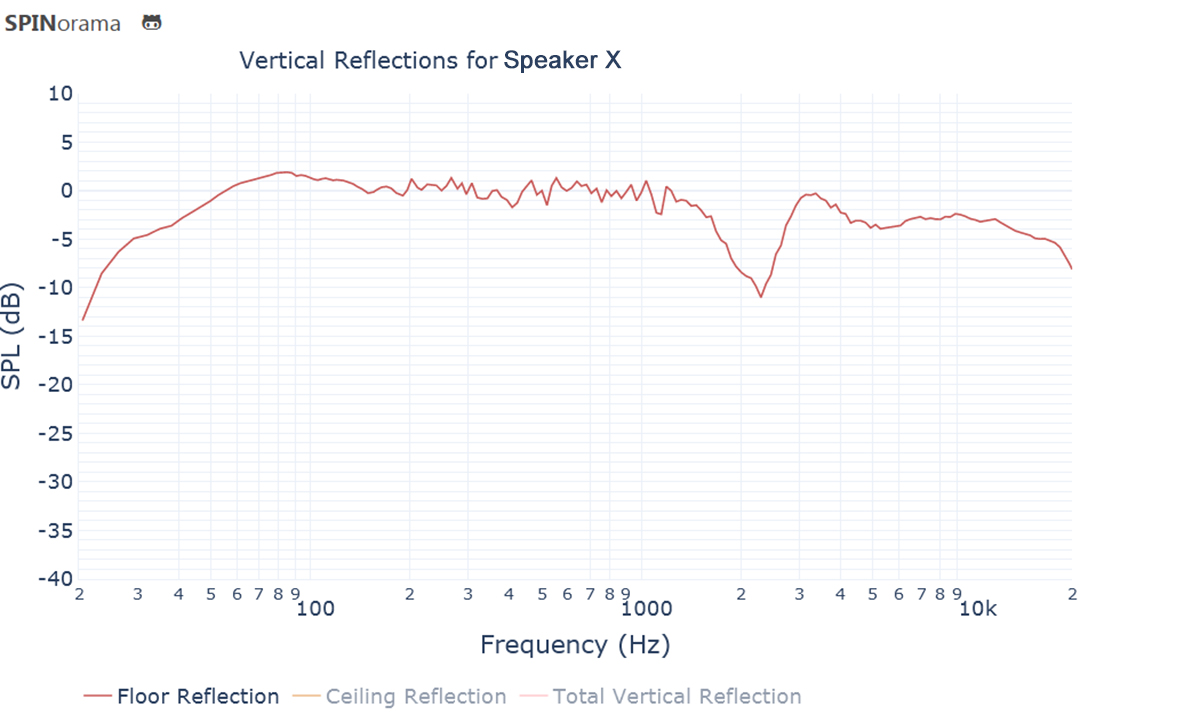
Speaker X, “CEA-2034 floor reflection” curve taken from Piere Albert’s site “Spinorama is a collection of speaker measurements” for a well-designed speaker in an anechoic chamber equivalent (Klippel near field scanner).
To appreciate how unique this is to Perlsiten let’s look at the CEA 2034 “floor reflection” of a high-quality speaker with good CEA “spin” curves. Above is a plot of the “floor reflection” isolated. As you can see it has no attenuation at all except around the crossover which has a dip that “colors” the reflection. Recall this is where the floor reflections are the most energetic in reflection since they have the smallest path to the ear.
This in-room measurement of the Perlisten R5m stand-mount speaker is an 18-point spatial average. A 9-point measurement was made for the right speaker and then repeated for the left speaker. Averaging both speakers is an approach that others have been using and publishing. Using data from both speakers reduces the modal response of the room by averaging the differences in the response of the two speakers from room asymmetries. The technique cannot eliminate them however and, as such, the response below 300Hz remains room dominated. The green trace shows the raw uncorrected room response of R5m which has a smooth and gently declining response between roughly 600 Hz to 20 kHz. Unlike the previously reviewed S7t and the recently released R7t tower speakers, the R5m is missing the two additional woofers that those speakers integrate with the DPC array to help quash those vertical reflections lower down in the bandwidth. Below 600 Hz, we see more of the room exercising its will with a couple of minor peaks in the response at 450 Hz and 550 Hz and two large peaks at 180 Hz and 110 Hz. The narrow, sharp dip at 160 Hz is most likely a floor bounce (the distance from the woofer to the floor and back to the speaker) which appears in all my speaker measurements in this room. Bass response is otherwise strong to 60 Hz, below which we have a steep rolling off. I’m guessing that the R5m is designed with a bit of a boost in the bass response to give the sound a bit more punch and power for a monitor. The predicted in-room response curve (supplied by the manufacturer and seen later in this section) seems to suggest that. Unfortunately, that was exciting those big peaks at 110 Hz and 180 Hz in my studio that I could not deal with simply by repositioning. The red trace shows the results from using Anthem Genesis room correction to a maximum of 600 Hz. ARC essentially took down the offending peaks and got me a few extra hertz of bass extension in the bargain. This result still gave me the punch I wanted in the bass without it interfering with the sound of the lower midrange.
Here we have the Impedance sweep for the Perlisten R5m. Results show much of the speaker’s operating range takes place between 3 to 5 ohms, with a minimum of 2.5 ohms. While I was able to get away with using my Anthem MRX1120 AVR to drive these speakers in my modest home theater, we strongly recommend using at least a separate robust multi-channel power amplifier to drive these loudspeakers safely and successfully.
Above is the Average In-Room response of the Perlisten R5c center channel speaker compared with the Perlisten R5m In-Room response. Both seem to match very well above 500 Hz, suggesting a near-identical tonal character. Below that there is a bit of a hump from 300 Hz to 500 Hz, a matching peak at 180 Hz to the R5m and then a roll-off in the response below 80 Hz. All indications are that a similar application of room correction, maxed at 600 Hz (in this case), would clean up these room-induced bass issues as they did with the R5m.
David Rich notes: The R5c is a sealed speaker and thus has less extension. This is common in center channels which will be near the floor. Room correction will take care of reducing the peaks and handing the center over to the subwoofer. Dips cannot really be fixed well with room correction.
Here is the Impedance sweep for the Perlisten R5c Center Channel speaker. Like the R5m, results show much of the speaker’s operating range takes place between 3 to 5 ohms. A robust separate multi-channel power amp is recommended to get the best out of this speaker.
Here is the nearfield response data for the R212s subwoofer provided by Perlisten. The curves show two measurements taken at each of the three EQ presets. One measurement is taken at the front-firing driver, while the other was taken at the vent space below the driver in order to capture the full results of the two push/pull drivers working together.
Here is the nearfield response data for the R212s subwoofer provided taken in my room. The curves show the same two measurements taken at each of the three EQ presets at the same positions as indicated above. Results are very close to the manufacturer’s data.
This is an average in-room response taken of the Perlisten R5m loudspeakers with the twin R212s subwoofers as a 2.2 channel configuration in my large studio space. ARC helped produce a seamless blend and an impactful stereo subwoofer response down to 27 Hz before rolling off just after that.
Perlisten’s R5m-based surround sound system delivers an overachieving stereo or multichannel music and movie experience in a more real-world-sized package! If your budget allows, audition these post-haste!
- Precise, dynamic, yet musical reproduction of serious capacity
- Novel DPC Array (in all speakers) controls those pesky floor and ceiling reflections that can muddy up the midrange and treble
- Both individually and as a system, the speakers excel at both music and movies; R5m monitors are surprisingly bass capable on their own
- R212s subwoofers are incredibly powerful and flexible
- Unique and attractive design
- Active versions of these and other Perlisten speakers; DSP and built-in amps are probably the only other addition that might unlock additional performance and flexibility from Perlisten’s DPC array
When I reviewed the Perlisten S7t-based surround sound system last year, it was a system very much of excess. It was an incredible performer in every respect, comprised of the company’s top-of-the-line gear. What’s not to like about that? I wondered though if Perlisten could do a smaller, more approachable system without giving up much in the way of that outright performance. The answer, in my mind, is a resounding yes. Taken individually, the Perlisten R5m is an excellent stand-mounted speaker. They can be easily used alone in a small to a medium-sized room (with quality amplification, as you’ll want some juice) to make an excellent sounding stereo system with a surprising low-end punch. Want to push it to the next level? Adding an R212s will get you there and then some with superb low-end performance, matching aesthetics, and lots of configuration options (if you are a bass-nut with a full pocketbook you’ll add two). Combine that 2.2 channel base with the R5c center channel speaker and the R4s on-wall surrounds, and you will have an outrageously capable home theater system, sized for the average home theater room.
The only caveat I have is that the price of a single R5m and its matching stand is only $705 bucks shy of a single R7t tower speaker. If you have a larger room or are not a fan of using subwoofers for a stereo setup, the R7t may be what you want to investigate if you can muster the extra $1,410 dollars for the pair. I had a chance to hear the R7t at the Florida Audio Expo and they sounded impressive.
Yes, this R5m-based system may still be out of the reach of many people. The price of this whole ensemble is roughly $25,000 as tested. And yet, taken as a whole, there is precious little this system can’t deliver on. Clear, immersive sound with dynamics to spare. Each speaker benefits from Perlisten’s novel DPC array to help control issues from floor and ceiling reflections delivering tangible results. Good looking, and well made with a moderate footprint to boot. If the world was my oyster, I would keep this R5m setup as my reference home theater and take a pair of S7t as my 2-channel reference system in my studio and call it a day!
The author would like to thank David A. Rich for his invaluable assistance with this review.


